|
H
|
|
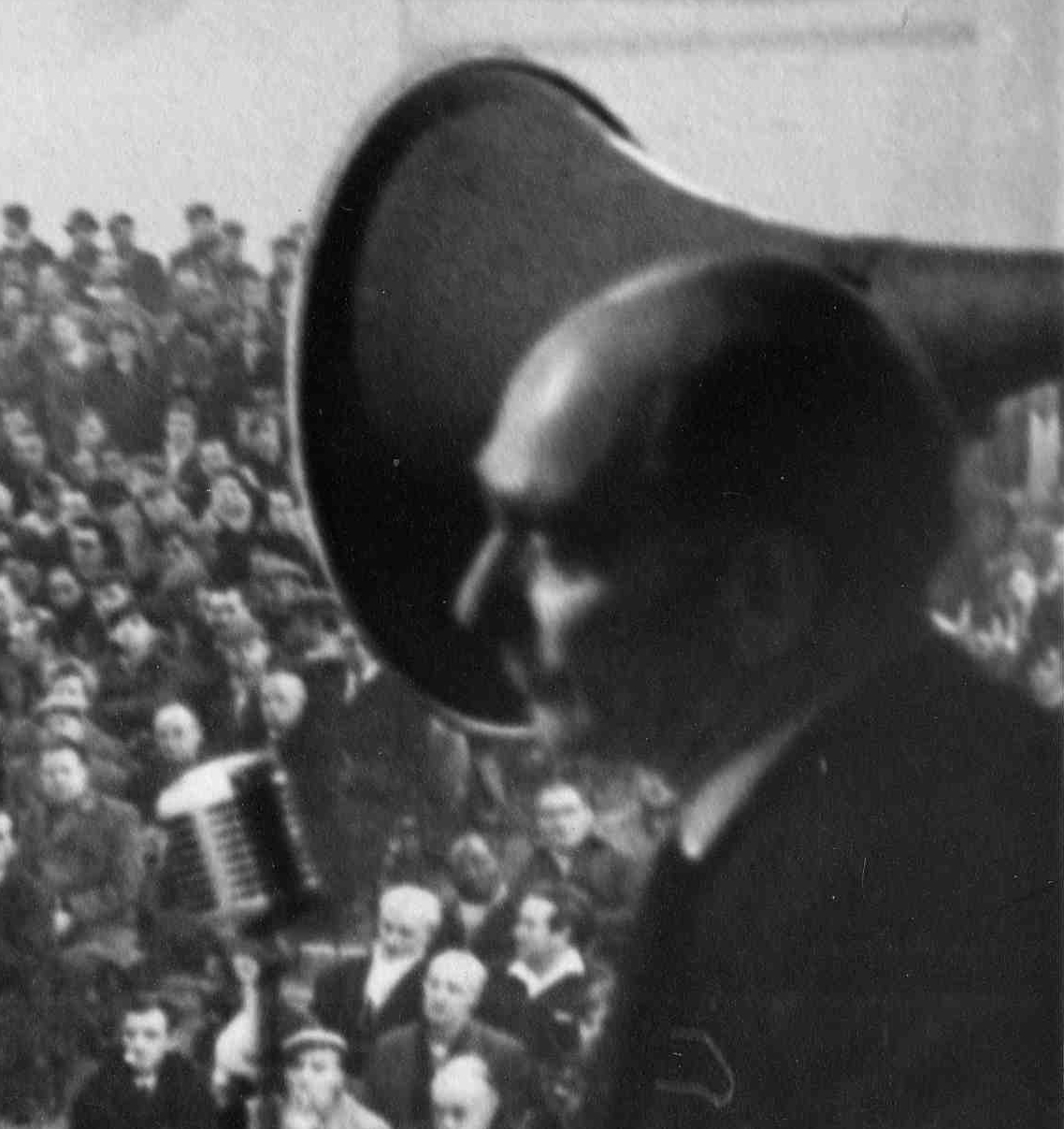 |
Born: Leicester 1907, died: January 1987, (Labour Party & Communist Party)
Albert Hall was educated at the Milton Street Board School before starting a five-year apprenticeship with a local wood working firm. In the late 1920s, he was living in the slums of Fleet Street and then managed to get a council house on the new South Braunstone estate. He then became one of leaders of the Braunstone Tenants' Association. During the 1930s he helped produce the Braunstone Gazette which was distributed free to tenants on the estate. He was very prominent in the campaign for local community facilities and lower rents.
He was also an active anti fascist and resigned from the Labour Party in protest over the party’s initial support for non-intervention in Spain. He was an active member of the Spanish Aid Committee and took in Czech refugees from the Sudetenland. In 1939, he unsuccessfully sort to challenge the T.U.C. ruling which banned Communists from serving on the Trades Council. In 1950 he tried again, but his motion was lost 61 - 42. He was a member of the Communist Party from the late 1930s, but left the party in the mid 1950s in protest at the Soviet invasion of Hungary. He was an organiser for the Amalgamated Society of Woodworkers for 26 years and Trades Council President in 1954 & 1970-1.
In the early 1960s, he lent his support to Arnold Wesker's Centre 42 activities. This culminated in a very successful arts festival sponsored by the Trades Council in 1962. There were exhibitions: of local artists' work, children's art and a Trade Union exhibition featuring John Bratby murals and photographs by Euan Duff of the daily life of a workman set against the history of the movement. Secondly there were theatrical events: Kops's Enter Solly Gold, Wesker's documentary play The Nottingham Captain, the National Youth Theatre production of Hamlet and, the most innovative work, Charles Parker's The Maker and the Tool, based on recordings made with workers of representative industries in each town.
Albert was a member of the Phoenix and later Haymarket Board as well as a governor of Charles Keene, South Fields and Leicester Polytechnic. He was also chairman of the East Midlands Housing Association. In the early 1970s, he was active in opposition to the government's legislation on trade unions. He wrote later:
It is a serious setback to our movement that the Industrial Relations Act is on the statute book, and whatever criticisms may have been made about T.U.C. strategy, no one can take away the glory of the tremendous demonstration in London on February 14th, 1971. The fact that 3,500 trade unionists stopped work in Leicester and marched and demonstrated at the Granby Halls on the morning of January 12th, was an indication of our detestation of legislation designed to violate every tenet of democratic control of our own movement, and to undermine our ability to fight a policy designed to weaken our ability to safeguard our hard won rights.
Sources: Leicester Evening Mail, 22nd February 1939, Leicester Mercury, 1st March 1950, 25th August 1982, 12th January 1987, interview Leicester Oral History Archive, author’s personal knowledge
|
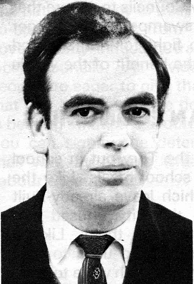 |
Born: County Durham, died: June 1992 aged 53 (Labour Party)
John Hall was an instrument maker and member of the E.T.U. (Electrical Trades Union) He was elected as both a City and County Councillor. During the 1950s and was a RAF electrician who witnessed Britain’s nuclear tests on Christmas Island. He suffered ill health as a result and in the 1980s, he became a leading light in the campaign for compensation for nuclear test victims.
Following his death from leukaemia, his case for compensation was raised in parliament by Keith Vaz MP. However, successive governments have refused to acknowledge any link between the tests and the ill health of ex-servicemen. His son Colin also served on the City Council.
Sources: Leicester Mercury, 4th June 1992
|
 |
Born: Arnesby, 1764, died Bristol: 1831
Every man must have a natural right to use his limbs in whatever manner he pleases, that is not injurious to another. In like manner he must have a right to worship God after the manner he thinks acceptable ; or, in other words, he ought not to be compelled TO CONSULT ANYTHING BUT HIS OWN CONSCIENCE.
Robert Hall was one of the 14 children and his father was the local Baptist Minister. He was educated at Mr Simmon’s school in Wigston, then at Dr Ryland’s school in Northampton, then at the Bristol Baptist College and finally as a Scholar to King’s College Aberdeen.
He became a minister in Bristol , where he also taught, but then moved to Cambridge, where he revived the local chapel, wrote books and pamphlets and became famous for his eloquent preaching. After a breakdown in health he returned to Leicestershire in 1806. As he recovered he returned to preaching and was appointed as minister of the plain, red-brick Baptist Chapel in Harvey Lane in 1807. In the early 19th century the Baptists were the most numerous nonconformist body in Leicester, although the Unitarians were more influential dominating local politics.
Robert Hall was active with those who agitated for peace in the wars with France and America, for the relief of poverty, for parliamentary reform and religious emancipation. In 1793 his celebrated Apology for the Freedom the Press and for general Liberty was published which discussed the right of public discussion, of political associations, the reform of parliament, the rights of man. A number of his sermons were printed as tracts including: On the Advantages of Knowledge to the Lower Classes (1810)
He was, with many other Whig supporters, a signatory in 1813 of a requisition demanding the use of the Town Hall for a meeting to demand parliamentary reform. The requisition was refused by the Tory Corporation, so the meeting was held at the Bowling Green Inn.
In 1818, the Leicester framework knitters in Leicester were agitating for better pay, better conditions and limitation of machine made goods. Robert Hall was active on their behalf. He was a leading proponent of disguising what was effectively a trades union (which by law was not allowed to pay workmen who were on strike) as a friendly society which could make payments to its members who were actually out of work because they were on strike. In 1821, with the unrest showing no signs of abating, Robert Hall published anonymously a pamphlet “The Question at Issue between the Framework Knitters and their Employers”, which attracted the wrath of William Cobbett in his Political Register. Although he was quite prepared to advise radicals and to write in their support, he kept put of political meetings and speech making.
He was, however, famous for his preaching. Apparently he would start in a low voice with a hesitating manner, but “as he proceeded”, said one listener, “his voice gained strength and flexibility, his utterance became more rapid, and so neat was his delivery that I have distinctly heard twenty or thirty syllables in one breath”. Shorthand writers attempted to take down his sermons, but failed. He poured forth a torrent of words while his body gently swayed and “his spirit seemed to be abstracted into the image he was creating“.
His audience contained not only his congregation, but also strangers visiting Leicester. Public speakers, barristers and Judges at Assize all made a point of hearing him. It was not uncommon for visitors to come from London by Saturday’s Mail Coach, attend his service and return to London on Sunday night. Apparently, John Ryley, the first editor of the Leicester Chronicle which was the mouthpiece of the radical Whig opposition in Leicester, moved from Cambridge to Leicester entirely for the purpose of enjoying Robert Hall's sermons.
Robert Hall's health was always poor and suffered extreme pain from a number of conditions. He bought laudanum by the pint to ease the pain, taking a full wine glass at a time.
In 1826, he moved to Bristol , where he died of heart failure aged 67. A statue of him was erected of him in 1871 on the imitative of John Burton.
Sources: A. Temple Patterson, Radical Leicester, Leicester 1954, John Webster Morris: Biographical Recollections of the Rev. Robert Hall
|
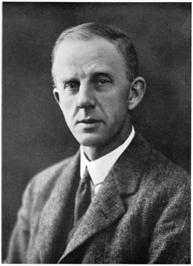 |
Born: Burton-on-Trent, 1877, died: December 1933 (I.L.P.& Labour Party)
Hallam’s father was a railwayman involved in the 1886 strike, for which he was subsequently victimised. As a result, the family moved to Leicester and his father began business as a coal merchant. Although Herbert had studied at Ruskin College, he went into the family business. Despite this, he was an advocate of the municipalisation of the coal trade (including his own business). He became member of the Fabian Society and was a believer in phrenology.
He was active in the Labour movement in 1904 and was elected to Board of Guardians in 1907. He was subsequently elected to City Council in 1913 for St Margaret’s’ ward where a high proportion of property was landlord owned property and which also contained some of Leicester's worst slums. With many landlords now raising rents, Hallam's election manifesto now advocated that the corporation should initiate a housing scheme:
“The outstanding fact was that in St. Margaret’s children died three times as fast as the children in Spinney Hill ward? Why? Because men like Mr Yearby (a Conservative councillor) represented themselves and their property owning friends, instead of protecting the lives of children.”
Hallam too was strongly influenced by the ideas of Town Planning. He opposed streets being laid out on the grid iron system of heavily paved streets running parallel and at right angles. His proposal, in 1914, that the Council should undertake a housing scheme was agreed by the Council, but delayed by war. In August 1914, he spoke out against the war in the Market Place arguing that:
We must stand firm in demanding peace. It is not the Russian people who are causing the war; it is a clique of diplomatists. War is not going to make either the workers or capitalists make a penny better off- it would make it worse for everyone. Should England range herself on the side of Russian diplomatists? No! The time is now ripe for a rearrangement of the balance of power in Europe. The advancing democracies of England, Germany, France and Italy should unite in helping to check the reactionary forces of Europe.
He stood as the Labour candidate for Loughborough in the 1918 general election and was heavily defeated.
In 1921, he became Vice Chairman of the first Housing and Town Planning Committee and after the death of Cllr Arthur Wakerley (Liberal) in 1924, he became its Chairman and was responsible for the planning and building of the Saffron Lane and the South Braunstone estate. He held this position until a month before his death. He stood firm against government pressure to build smaller (non-parlour) council houses and advocated parlour houses which had two living rooms downstairs.
“Let me give you an idea of how a parlour should be furnished. This is it: a table a few easy chairs and all the books you can afford. By this simple method of furnishing, the parlour would become a place in which the various members of the family would retire when they had important work to do. Gas and electricity should be laid on in all houses and there should be a continuous supply of hot water. Electricity will soon be used in every household, and so reduce the housewife's hours of labour to those of the miner. Why should we demand 6 hours a day for men and be content to let women work twice or three times as long.”
He was regarded as being an intellectual and was described by the Tory Leicester Mail as: ‘the most gentlemanly socialist we know….’ He is commemorated by Hallam Crescent, Braunstone Estate.
Sources: Howes, C. (ed), Leicester: Its Civic, Industrial, Institutional and Social Life, Leicester 1927, Leicester Pioneer, 9th January, 13th March, 7th August 1914, Leicester Evening Mail 6th December 1933
|
|
Born: c1868 died: 1936 (Labour Party)
Henry Hancock Hancock was a draper by trade and a Quaker. He was president of the Friends' Adult School and a teacher at Westcotes Congregational Sunday School. He was also a magistrate and a founder of the W.E.A. in Leicester. He was a elected as a Guardians of the Poor in 1913 and became chair of the board in 1924. In 1917, he drew attention to Leicester's high rate of pauperism in contrast to other similar cities. He was a Labour candidate for Belgrave in 1925 and eventually won Westcotes in 1927 (Lab gain). His political career ended in ignomy when he nominated the prominent Tory J.L. Harrison rather than Amos Sherriff as chairman of the new Public Assistance Committee. He resigned from the Council shortly after.
Sources: Leicester Daily Post 22nd September 1917, Leicester Evening Mail 4th March 1930, 3rd September 1936
|
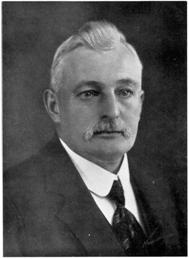 |
Born: 12th February 1865, died:1948 (I.L.P.& Labour Party)
Harry Hand was the eldest child of a large family and attended Charnwood Street Board School, he was at work as a part-timer at the age of 8 and left school aged 11. After a series of dead end jobs he was apprenticed as a carpenter and joiner, joining the Amalgamated Society of Carpenters and Joiners in 1886. However trade depression meant that he had to seek work in Sheffield and Birmingham. Returning to Leicester he worked as a journeyman until the outbreak of war. Early in 1915, he set up in trade on his own account as a joiner and shop-fitter.
In 1886, he joined the Amalgamated Society of Carpenters and was branch secretary for nine years. He was a founder of the Leicester Labour Party in 1903 and became Vice Chair of the Labour Party in 1907. He was elected councillor for Abbey ward in 1909 and served until 1945. In 1914, he was the co-sponsor, with Herbert Hallam, of a proposal for council housing in Leicester. In 1918, he became president of the Labour Party, succeeding George Banton. In 1924, he became the chairman of the Labour Group on the City Council and was made an alderman that year. He was Lord Mayor 1928-29. He was vice chairman of the Housing Committee during the 1930's. He was a prominent member of the City of Leicester Working Men’s Club (Bond Street) Speaking in the Market Place in 1923 he is reputed to have demanded ‘Homes for the homeless, boots for the footless.’ He studied music in his spare time at Vaughan College and sang in St Luke’s and later St Saviour’s choir. He is commemorated by Hand Avenue, Braunstone Estate.
Sources: Howes, C. (ed), Leicester: Its Civic, Industrial, Institutional and Social Life, Leicester 1927, Leicester Pioneer 20th June 1924
|
|
Born: Sedgefield, Durham, 13th May 1921, died: Leicester 3rd February 2007 (Labour Party)
Joe Hardy was one of Leicestershire's best known trade unionists. He started work as a joiner in his native North East. In 1947 he became a branch official for what was then the Amalgamated Society of Woodworkers and became the regional organiser of the Construction Workers Allied Trades and Technicians Union in 1966.
From 1953 to 1961 he served on the Leicester City Council representing Humberstone and served on the regional executive committee of the Labour Party. He became secretary of the Leicester & District Trades Council in 1957 and resigned in 1974 to become secretary at the newlu formed TUC East Midlands Regional Council.
He was chairman of the Area Manpower Board and was made an MBE for his services to employment in 1973 and received the Queen's Jubilee Medal for his services to the trade union movement in 1977. He became a magistrate in 1963.
Sources: Leicester Evening Mail, 1st May 1963, Leicester Mercury, 24th April 1974, 28th May 1986
|
|
(I.L.P.)
Charles Harris became the president of the Trades Council in 1892. He was also elected to the Board of Guardians for Wyggeston in 1905 and campaigned for the unemployed with George White. He was re-elected in 1913. He was a member of the Labour Party executive 1910.
|
|
Died: December 1905, aged 65 (Co-operator)
Henry Harrott was a frame smith. He was elected to the board of the L.C.S. in 1872 and on his death had been its secretary for 18 years.
Sources: Leicester Pioneer 23rd December 1905
|
|
Born: Bradford 1854, died: 1918 (I.L.P., S.D.F., B.S.P. and Clarion)
E.R. Hartley spent most of his life in Bradford. His started out as a half-timer in a factory later becoming an apprentice butcher, eventually setting up in business on his own. He became a Socialist in 1884 and was involved with the formation of the I.L.P. In 1895 he was elected to Bradford Council and elected again in 1898, becoming an alderman.
After 1901, he gave his allegiance to the S.D.F. after a disagreement with the I.L.P. He was involved with the Clarion vans and was an unwearying propagandist, visiting Leicester several times. However, his propaganda work was always enlivened with a dry caustic humour, which was always disconcerting to opponents. This gift of humour made him much sought after as a lecturer. His parliamentary contests were numerous and unsuccessful. There were many that considered that his relentless opposition to anything in the way of canvassing helped him to loose votes that he might otherwise would have obtained. This did not apply to bye-elections where the fight was a rushed one, but to steady fights for the SDF in East Bradford in 1906 and 1910. He was a candidate for the I.L.P. in Dewsbury (1895), Newcastle (1908 & 1913) and stood for the British Socialist Party in Leicester in 1913, after George Banton was prevented from standing. He polled 2,580 votes, somewhat less than expected.
Sources: Leicester Pioneer, 1st February 1918
|
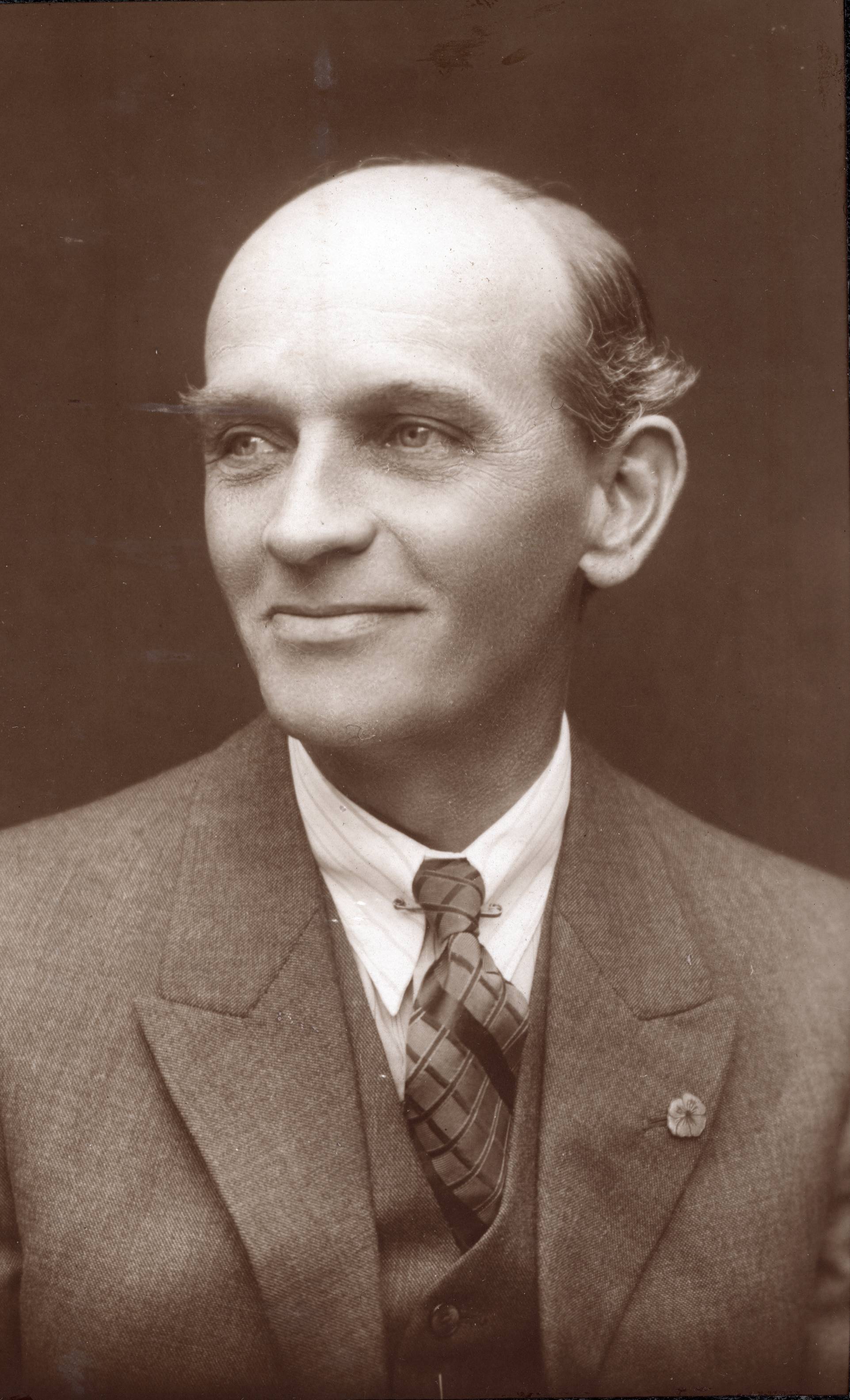
Harry Hassell
|
Alonza Charles Hassell born Leicester, 24th October 1889 Died: December 1965 (Secularist)
Ernest Harold Hassell born Leicester 19th September 1883, died October 1948 (Secularist)
Albert E Hassell born c1900
Both Charlie and his brother Harry grew up in Northgate Street where their father had a fruiterers' shop. Before WW1, Harry Hassel worked in the shoe trade whilst Harry was a tram conductor. Both brothers were Secularists. Younger brother Albert (born c1900) worked as a cinematograph operator.
Charlie Hassell was member of the I.L.P and No Conscription Fellowship. When he was called up in 1916, aged 26, he declared himself a conscientious objector. In May 1916, he was granted “Exemption from Combatant Service Only” following a hearing by the local tribunal hearing and assigned to the Army's Non Combatant Corps. The NCC was formed with the deliberate aim of freeing up soldiers behind the lines from routine labour and logistics tasks, giving the army more effective fighting men for the front lines. Charlie believed that the NCC aided the war effort and he wanted full exemption from military duties.
His refusal to co-operate with the military authorities meant his was given Field Punishment no. 2 at Glen Parva barracks. This involved being kept in irons though not tied to a fixed object. He would have undergone hard labour and made to march in full order with packs and rifles twice daily, usually morning and afternoon. Soldiers under field punishment no.2 were not allowed to smoke or drink any rum; were only allowed blankets and made to sleep on the floor.
At a court martial at Richmond Castle in July he was given 112 days in Durham Prison for disobeying an order, but was transferred to the Home Office Scheme after three months and sent to Warwick, Dartmoor and Knutsford. He was not discharged from the army until 1920. After the war he became a shop worker and volunteered for A.R.P. durring WW2.
18 year old Younger brother Albert was arrested iin Leicester Market Place on the morning of Sunday 13th October 1918, for failing to join the Army. He told the magistrates that he had appealed unsuccessfully to the Appeals Tribunal on conscientious grounds and he would not became a soldier. He was handed over to the military authorities
Both Charles and Harry were stalwart members of the Leicester Secular Society, Charlie was the Secular Hall's manager in the late 1920s.. Ernest Hassell, known as "Harry", worked as a sole cutter in the boot & shoe trade and lived at 74 New Park Street. He was Vice-President of Leicester Secular Society from 1923 to 1938, and President from 1939 to 1948. He was also a Trustee of the Leicester Rationalist Trust during this whole period. When Harry died in October 1948, the minutes of the Society record that his death came as a misfortune of the first magnitude and that the Society had lost a guiding force.
Sources: Leicester Daily Post 15th October 1918, Leicester Secular Society minutes, British Army WWI Service Records, 1914-1920, Census returns.
|
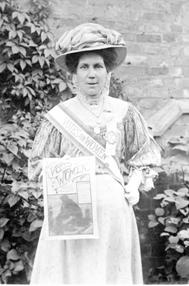


|
Born: Stafford, 4th March 1863, died: 11th March 1946 (I.L.P., W.S.P.U.)
Alice Hawkins came from a working class background and left school at the age of 13 to become a machinist in the boot and shoe trade. In her early twenties she was taken on by the Equity shoe factory and was active in the No 3 branch (woman’s branch) of NUBSO. She was a founding member of the Leicester I.L.P. and in 1894 was vice president of the women’s I.L.P. In 1901, Alice and her husband Alfred (also from Stafford and born c.1858) joined the Leicester Secular Society. Alice was a member of the Clarion Cycle Club and in 1902 a newspaper reported that she was accused of “outraging public decency” by riding in rational dress. (bloomers) She assisted in the formation of the first Leicester Labour Club.
In 1905, both Alice and Alfred played a prominent role in the organisation of Leicester's famous unemployed march. In 1906, she was a founder member of the Women’s Labour League, though, less than a year later she deserted the W.L.L. for the more militant W.S.P.U.
In 1907, she attended the W.S.P.U. rally in Hyde Park and following a march on the House of Commons, she was arrested and sent to prison. On her release, she invited Sylvia Pankhurst to speak in Leicester and the Leicester branch of the WSPU was formed soon after. It is thought that Alice is the subject in one of Sylvia Pankhurst’s painting made at the Equity shoe factory. She wrote that “... at night I held meetings for the local WSPU, amongst whom, only Mrs Hawkins, as yet, dared mount the platform.”
Alice and her Leicester colleagues began a tireless campaign of speaking at factory gates, market squares and village greens throughout Leicestershire and parts of Northamptonshire. Alice and her fellow suffragettes used their bicycles to travel to the nearby countryside and neighbouring towns. In 1909, Alice, with the support of Gladice Keevil of the Birmingham WSPU, spearheaded a bicycle drive to increase membership in the WSPU by targeting supporters beyond town's boundaries. It was so successful that enough new members were recruited to establish a new WSPU satellite branch in Loughborough. In the summer of 1910, Hawkins and others suffragettes set out every Sunday morning to rural villages including Syston, Shepshed, Castle Donington, Kibworth, and Melton Mowbray, ranging from 6 to 30 miles away. Once they arrived at their destination, they held open air meetings, greeted supporters, distributed WSPU literature and solicited donations.
Alice went to prison five times for various militant actions which included chaining herself to railings, throwing a stone through a Home Office window, pouring ink into letter boxes and making a disturbance when Winston Churchill held a Liberal meeting at the Palace Theatre in 1909.
Her husband, Alfred was a committed socialist and supported her in the suffragette campaign. On one occasion, he followed Winston Churchill to a meeting in St George’s Hall, Bradford and heckled him over the issue of votes for women. The stewards threw him out the meeting and down a flight of stairs breaking his leg. The Men’s Political Union successfully sued the Liberal party and gained £100 compensation. Alice’s presence in the branch ensured that the WSPU in Leicester did not become a totally middle class organisation, despite the national direction of the movement.
In 1911, Alice Hawkins became president of breakaway Independent National Union of Boot and Shoe Women Workers, which was led by her colleague Lizzie Willson. Both women were already delegates to the Trades Council. In 1913, Alice wrote:
I have worked at the shoe trade from the age of thirteen. I was married in 1884, and am the mother of seven children, of whom five are alive. I early began to find out there was something very wrong with the lives of women workers. Twenty years ago I joined the I.L.P. and my trade union, and have worked for the uplifting of my sex ever since. For the last eight years I have been organiser and hon. president of the Women's Boot Union, but was never satisfied with the conditions of women's labour as compared with men's. I joined the militants in 1907 to fight for the weapon which men have to push their trade union principles into the only place - namely, Parliament - where it was possible to better their conditions. I have been four times in prison, three times in London and once in Leicester, where I hunger struck as a protest against being treated as a common criminal.
I was in London on Black Friday and the following Tuesday. I have spoken in Hyde Park, and been in several processions. I am still working in my trade union as president and organiser, and am doing good work by rousing them to a sense of their needs.
By 1913, the Suffragettes had been physically assaulted several times during meetings and the windows of their shop on Bowling Green Street had been broken. Public speaking had become so dangerous for the Suffragettes, that the Leicester Watch Committee asked the WSPU to refrain from any further public meetings. Alice Hawkins refused and under the watchful eye of the police she continued to speak in the marketplace and hold parades around the town. The Leicester Mercury even suggested that the second wave of letterbox attacks around the town centre in May 1913 was a direct response to Alice Hawkins and her daughter being attacked by an angry mob in the marketplace.
Alice Hawkins was arrested for damaging the Royal Mail with a "deleterious substance" (Brunswick black ink). She pleaded guilty and was sent to prison for seven days. In her defence she claimed it was a political offence and refused to take food. But primarily due to failing health and a request by her close family, she declined to hunger-strike and was spared the indignity of being force-fed.
Her three sons served in the First World War and, like Mrs Panhkurst, Alice was a fervent supporter of the war. In 1918, she appeared on platforms with Jabez Chaplin to condemn the 'cowardice' of the I.L.P. However it seems unlikely that she joined the short lived Women's Party, founded by Emmeline and Christabel Pankhurst in 1917. After the war, she continued with her involvement in the local Trade Union and Labour movement. In 1945, she was worked for the Labour Party in the main committee room in the De Montfort Ward. She died at her son's home in Herrick Road the following year.
In 2018, a statue of Alice was unveiled in the new market square, behind the Corn Exchange, to mark her contribution to the campaign to win the vote for women.
Sources: The Suffragette, 24th January 1913 Leicester Pioneer, 4th July 1913 & 16th August 1918, Leicester Evening Mail 12th March 1946, Richard Whitmore, Alice Hawkins and the Suffragette Movement in Edwardian Leicester
|
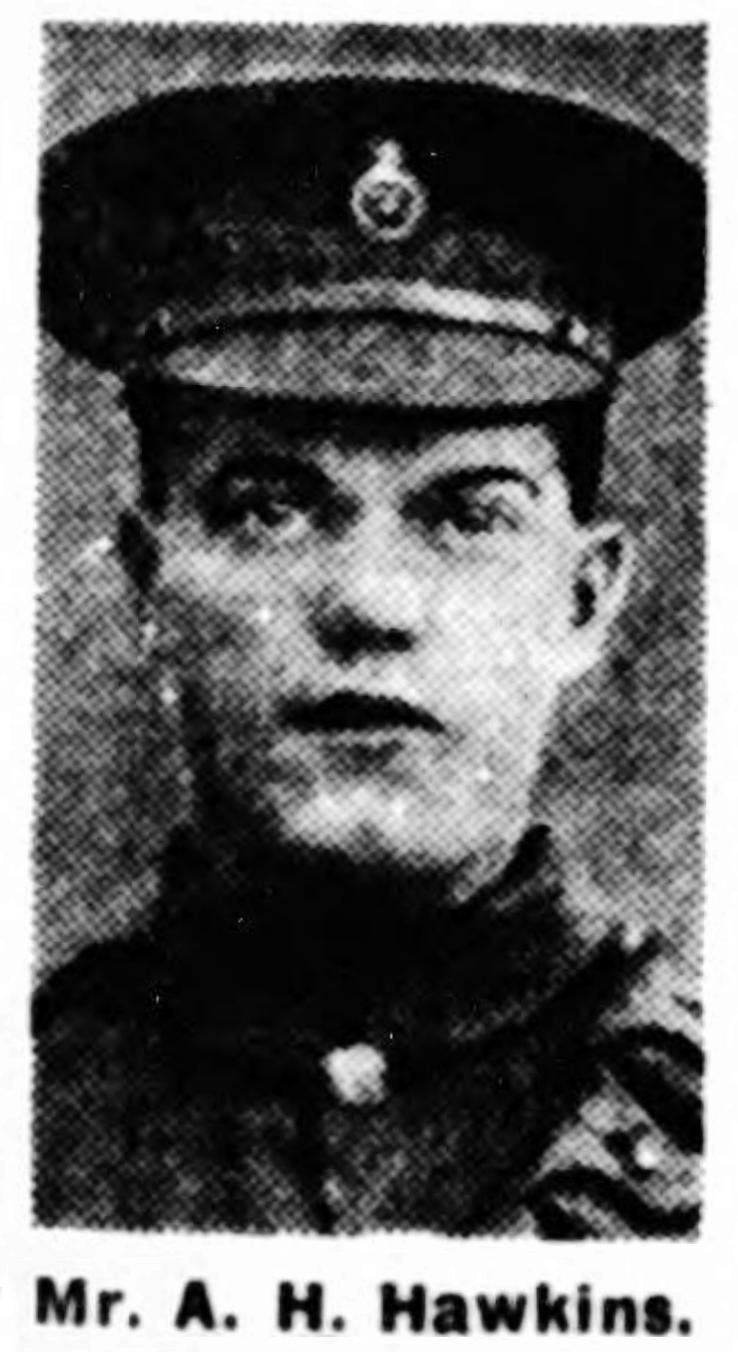 |
Born: Leicester 1889, Died? (Labour Party)
Alfred Hawkins was the son of Alice Hawkins. During WW1 he served in both the army and navy, after the war he worked as a school caretaker. He was a member of the Transport and General Workers Union and became president of the Trades Council in 1936. That year he was also was a delegate to the Leicester Peace Council. In her old age, his mother lived with him at his house on Herrick Road.
Source: Leicester Evening Mail 18th March 1936, 27th January, 18th March 1938, Census returns
|
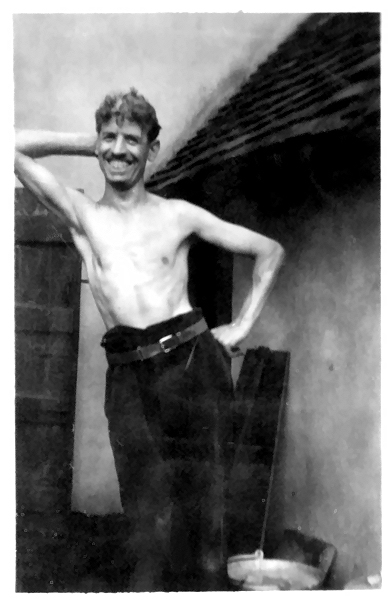 |
Died c1983 (Communist Party)
From 1926 to 1940 Arthur Haywood worked as a tram driver for Leicester City Transport. He started on the trams in the year of the General Strike and his first pay packet was strike pay.
He was a former pupil of Moat Road School and was well-read, cultured and played the violin. According to his grandson, he was a very strict, obstinate and opinionated man who loved Russia and idolised Stalin. This caused no end of family rows and rifts.
In August 1940, he was sacked from his job on the advice of the Chief Constable. Arthur appears to have lost his job on the very day he was given his 15 year Gold Medal for safe driving. His dismissal was raised in the House of Commons by Willie Gallacher MP, the Communist member for West Fife. He asked: Is the Minister aware that there is nothing whatever against this man so far as his employment is concerned, and that he has said or done nothing against the law of this country? Can the hon. Gentleman give any reason why the police should advise that a competent worker,... should be removed from his employment? Gallacher did not manage to elicit a reason for his sacking which remains a mystery to this day. In 1944, Arthur moved to Coleorton and he died alone, divorced, near Sutton on Sea around 1983.
Sources Hansard, 13th August 1940, R Haywood
|
|
(Labour Party)
President of the Trades Council 1967, delegate from the U.S.D.A.W. and also full-time official.
|
|
Born: Thringstone 1817, died 18th May 1885 (Co-operator)
Born in humble circumstances, he owed his education to his father’s knowledge and was a bread winner from an early age. Even when he attended Dames School in Thringstone, he took stockings to mend. From the age of 13 or 13, he worked in Nottingham’s lace factories and in 1860, he and his wife moved to Leicester where he worked as a stockinger. He was member of the Methodist New Connexion domination
Benjamin Hemmings and Daniel Merrick were members of a short-lived Co-operative Society started by Thomas Cook in the Amphitheatre, Humberstone Gate. It was set up to sell the ‘essentials of home consumption.’ It sold potatoes from a yard on London Road and had a place for the sale of flour in Bowling green Street. Benjamin Hemmings joined the committee of the LCS in 1868 and became its president in 1870, being re-elected every year until his death.
Although a naturally cautious, modest and unassuming individual, he played a significant role in the society’s development and expansion. Beginning with the opening of branch stores and ending with the opening of the High Street Central store. During the period of the society’s financial difficulty (1877-80), he retained the confidence of the members. In middle age he was a foreman in a hosiery factory. After his death, portraits of him were available at the High Street store.
Sources: Leicester Co-operative Record, June 1885 (obit), Leicester Co-operative Society, (1898) Co-operation in Leicester
|
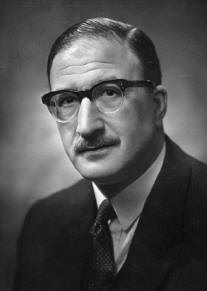 |
Born: Leicester, 11th February 1911, died: 30th Jan 1979 (Labour Party)
Mark Henig was educated at the Wyggeston Boys School. On leaving school he went to work in his father's Company, Henig & Sons Limited, Wholesale Textile Distributors, Burley's Way of which he later became a Director.
He was elected to the City Council in 1945. After losing his seat in 1947, he returned by way of a bye-election in North Braunstone in 1949. He was secretary and whip of the Labour group from 1949 until 1962. In 1965, he became the leader of the group, however within a year or so he was made chairman of the Association of Municipal Corporations and had to give up being leader and chairman of council committees. He was twice president of the Labour Party, its treasurer for eight years and became an alderman in 1958 and Lord Mayor 1967. He served on a long list of other public bodies as well as holding major offices in the Leicester Synagogue. He retired from local government in 1970 and became chairman of the English Tourist Board. He was described as one of the most dynamic and forthright councillors of the post-war years.
Sources: Leicester Mercury, 31st January 1979, Leicester City Council, Roll of Lord Mayors 1928-2000
|
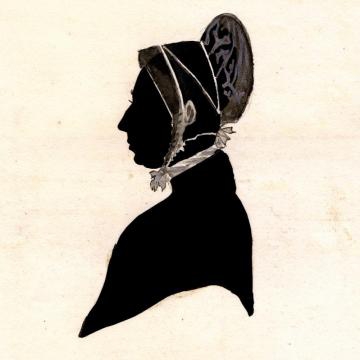 |
Born Leicester: 1789, died: 1831 (Anti slavery and radical campaigner)
She was born Elizabeth Coltman and her father, John Coltman, was a manufacturer of worstead cloth and a Unitarian. Her mother Elizabeth Cartwright was a poet and writer. As a young woman, Elizabeth was exposed to radical politics and the writings of Thomas Paine. She met John Wesley when he visited the family house and soon after became a practising Methodist. She had a natural ability for painting landscapes and in 1787 she married John Heyrick, a lawyer and a descendant of Robert Herrick the poet. When he abandoned the legal profession to serve in the 15th Light Dragoons, Elizabeth followed, residing with him in barracks in England and Ireland. He eventually returned to Leicester and took up an appointment as a Captain with the Leicestershire Yeomanry. According to her biographer: "The marriage was said to have been stormy, but she mourned fervently, with lifelong observance of the anniversary of his death. They had no children."
John had died in 1795 when Elizabeth was only 25. She moved back into her parents home, renouncing all worldly pleasures, and in 1809 became a Quaker. For a time she ran a school in her home, but this did not absorb all her energies and she found an outlet for her compassion in many charitable works and social reform. Her friend, Susanna Watts, who was 20 years older, no doubt encouraged these endevours.
Elizabeth was deeply concerned for the welfare of the long-term imprisoned and she became a prison visitor. In 1809 she stopped a bull-baiting at Bonsall in Derbyshire by purchasing the bull. By the 1820s, she had became one of the most prominent radical women activists.
As well as becoming a prison visitor, she wrote political pamphlets about a range of issues, from the Corn Laws to the harsh treatment of vagrants. However, her overriding interest was in the abolition of slavery in the British colonies. In the early 19th century, campaigners who wished to see an end to slavery in the British West Indies had two approaches to the problem. Some wished to push for a gradual end to slavery, on the understanding that eventually the existing slaves would die and along with slavery itself. Others, like Elizabeth, wanted a complete and immediate abolition of the institution of slavery.
Elizabeth Heyrick was a strong supporter of complete emancipation for enslaved Africans. In 1824 she published a pamphlet anonymously entitled Immediate, not Gradual Abolition, which was influential in encouraging public opinion to support the cause. She criticised the principal anti-slavery campaigners, William Wilberforce and Thomas Clarkson, for what she regarded as the overly slow and cautious way in which they had led the campaign in parliament up until that point. For her the call for gradualism by these men was “the very master-piece of satanic policy”. She stated:
"The West Indian planters, have occupied much too prominent a place in the discussion of this great question. The abolitionists have shown a great deal too much politeness and accommodation towards these gentlemen."
"..The perpetuation of slavery in our West India colonies is not an abstract question, to be settled between the government and the planters; it is one in which we are all implicated, we are all guilty of supporting and perpetuating slavery. The West Indian planter and the people of this country stand in the same moral relation to each other as the thief and receiver of stolen goods"
The pamphlet was widely distributed and caused much discussion in public meetings in various parts of England. Wilberforce gave out instructions for leaders of the movement not to speak at women's anti-slavery societies, most of which supported Heyrick. In his view:
"....for ladies to meet, to publish, to go from house to house stirring up petitions were things unsuited to the female character, as delineated in Scripture."
In 1824, the ladies organised a boycott of sugar from the West Indies. This was done to promote public awareness of the issues of the slave trade and to hit the profits of the planters and importers of slave-produced goods. For them, direct action was the way forward. Elizabeth argued that abstinence from sugar by only 10% of the population would defeat the interest and machinations of the 'West Indian gentlemen.' "It is therefore a grave error to disdain simple individual action through abstinence and to prefer the ‘pomp and circumstance’ of legislative enactment.”
The women visited local grocers' shops to persuade them not to stock sugar and claimed that 1,500 families were 'abstaining' from the use of West-Indian sugar. She was helped by Lucy Townsend, Mary Lloyd, Sarah Wedgwood and Sophia Sturge. Later that year, together with her sister Mary Ann Coltman and Susanna Watts, they launched an anti slavery periodical, The Hummingbird.
Her message was clear cut. She described the West India planters as being like thieves and those who bought their produce, like receivers of stolen goods. She asked, why petition Parliament when we can take swifter action ourselves? She wanted all slavery ended forever. She criticized the mainstream anti-slavery figures for being slow, cautious and accommodating. They also met with opposition and ridicule from the Tory supporting Leicester Journal which did not support abolition at all.
".... neither John nor his family will pay any kind of attention to the prejudices and passions of these canting hypocrites. We have no wish see sugar, coffee, rice, &c. &c. doubled and trebled in price; the West Indies depopulated, and their merchants ruined; and both the trade and the islands fall into the hands of our French, Dutch, and American rivals. That these would be the following consequences, if the doctrines the emancipationists of the dear blacks in the West Indies were attended too."
In 1825, she became treasurer at the inaugural meeting of the Female Society for the Relief of Negro Slaves and the Leicester Ladies Anti-Slavery Society branch was formed the same year. In 1830, the Female Society for Birmingham submitted a motion to the National Conference of the Anti-Slavery Society calling for it to campaign for an immediate end to slavery in the British colonies. She published several more anti-slavery pamphlets, sometimes addressing women specifically.
She was the author of more than twenty pamphlets and other works on subjects as diverse as bull-baiting, prison reform, war, the plight of the poor, vagrancy, wages, corporal punishment and election reform. Towards the end of her life she became involved in the campaign against capital punishment.
Elizabeth Heyrick never lived to see the passing of the Slavery Abolition Act 1833. She died on 18 October 1831 and is buried in Leicester. Her admirers in the USA included Benjamin Lundy, William Lloyd Garrison, Frederick Douglass, and Lucretia Mott. For Mott her work became an argument for women’s participation in public life and social reform. Garrison praised her on his visit to Britain in 1840, for instance in a public speech given at Glasgow. A Brief Sketch of of the Life and Labours of Mrs Elizabeth Heyrick, published anonymously in 1862 and probably by her niece Alicia Cooper, called her “one of the noblest pioneers of social liberty, not only for her own sex, but for mankind at large.”
Sources: Shirley Aucott, Susanna Watts, Dr Isobel Grundy, Women’s Writing in the British Isles from the Beginnings to the Present, Leicester Journal, 24th & 31st July 1829, A. Temple Patterson, Radical Leicester, Leicester 1954, A Brief Sketch of the Life and Labours of Mrs. Elizabeth Heyrick 1862, Wikipedia
|
|
Died: October 1911
In 1907, George Hern and his team of 12 assistants formed the Anchor Tenants Building Society which was responsible for the construction of the Humberstone Garden Suburb. Hern modified the layout drawn up by Raymond Unwin. George died in October 1911. A beech tree was planted in his memory at the bottom of Fern Rise.
|
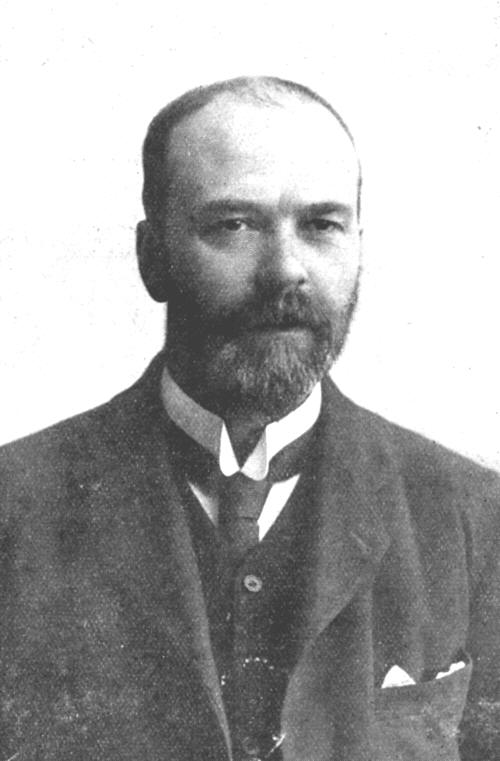 |
Born: 1866 died: July 1945 (I.L.P. & Labour Party)
Alf Hill was a village boy, born in Welwyn, Herts. He became an apprentice clicker in the shoe trade at the age of 13. After completing his apprenticeship, he came to Leicester in 1885, joining N.U.B.S.O. No. 2 branch in 1890. He was elected branch president in 1898 and president of the Trades Council in 1901 and 1916. He was a delegate to the Trades Council from 1893-1943. He was described in 1903 as a prominent member of the local Peace Society, he has always, in and out of season, raised his voice in favour of peace and to oppose militarism. He was a Town Councillor for Wyggeston ward 1905-19, being made an alderman in 1919. On the first Sunday in August 1914, he felt compelled to leave his religious work (he was a Primitive Methodist preacher) and take part in a political demonstration on a Sunday.
“No orator thrilled the crowd as Alfred Hill did. He spoke with a fervour and passion that told of the fierce earnestness of his soul, against the black hellish horror through which the nations of the world have since passed. He spoke for peace, as a man inspired, and no jingo raised his voice for war on that memorable day. In the war that followed, he never wavered in his stand for peace and although it meant a certain amount of unpopularity and brought on his shoulders a certain amount of abuse, he came through as a man who could stand for great religious and political principles.”
He was elected to Parliament for Leicester West in 1922, taking back the seat for Labour from J.F. Green of the National Democratic Party (pro war, anti-Labour coalition). In 1923 he stood down in favour of W. Pethick-Lawrence because of illness. He was no relation to T.R. Hill.
Sources: Leicester Pioneer, 27th June 1924
|
|
Born: c1836, (Leicester Democratic Association, Leicester Republican Association, Liberal)
Joseph Hill was active on the radical wing of the Liberal Party and a supporter of P.A. Taylor MP. He lived and Rudkin Street near Wharf Street and was a clicker in the boot and shoe trade. He was active in support of the nine hours movement in 1871 and was anxious to increase working class representation. In 1871, he was secretary of the Leicester Democratic Association which became the Republican Association the following year. The objects of the Republican Association were the repeal of primogeniture, game laws, the creation of equal electoral districts, universal suffrage, secret ballots, the payment of M.P.s, triennial parliaments, direct, rather than indirect taxation, a national poor rate, and the dissolution of the House of Lords and the disestablishment of the Church of England.
The Republican movement in Leicester sought to work within the Liberal Party and although it was only short-lived, it was the precursor of the socialist groups of the 1880s. However, Hill was not a supporter of the Paris Commune and condemned the extremes of the ‘Communists’ and the party of ‘order.’ In 1873, he criticised the founding meeting of the National Republican League for meeting on a Sunday, since there were many Christian republicans. He was, however, a supporter of the Sunday opening of museums. The Association had a large working class membership.
Sources: Midlands Free Press, 3rd June & 13th June 1871, Leicester Chronicle 22 April, 3 June 1871
|
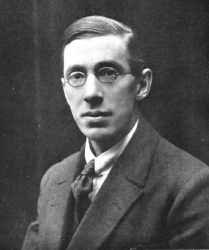 |
Born: 22nd May 1885 died: 1968 (I.L.P. & Labour Party)
Rowland Hill attended Melbourne Road Board School entering as a new boy on its day of opening in 1892. He was active in the Labour Movement from 1905 and became president Leicester branch National Union of Clerks in 1909. By 1914, he was president of the Trades Council and was secretary of the I.L.P. in 1917. He was Vice President of the local branch of the Union of Democratic Control which sought to put a reasoned case against the First World War. He was a conscientious objector and, in 1917, he had his conscription deferred as a result of a petition to the military tribunal. However, at the end the period of deferment he had to go ‘on the run,’ to avoid call up. At this time he wrote for the Leicester Pioneer under the pen name ‘Robert Dale.’
From 1919, he acted as agent for the Harborough Constituency and from 1926-32 was secretary of the Trades Council. He was also a director of the Co-operative Society during this period. He stood for Spinney Hill in 1920 and lost. He eventually won Westcotes ward in 1926, but was defeated in 1929. He was eventually elected back to City Council 1930 for Westcotes Ward as a result of a bye-election.
He commenced his career in a commercial office and held jobs connecting with the building and shopfitting trades. He was director and secretary of Harry Hand (Shopfitters) and also of the City Sheet Metal Works.
He became chairman of the City Council Labour Group 1937 and was the longest serving chairman of the Finance Committee, holding the post from 1934 until 1955. Although Labour was not in the majority for most of that time, it became customary for committee chairs to come from different parties. Rowland Hill was re-elected in 1945 and became Lord Mayor in 1951. He was awarded a C.B.E. in 1955 and the freedom of the City in 1956 and continued on the City Council until 19?. His daughter Mrs Janet Setchfield was also a councillor and also became Chair of Finance and Lord Mayor.
Sources: Leicester City Council, Roll of Lord Mayors 1928-2000, Howes, C. (ed), Leicester: Its Civic, Industrial, Institutional and Social Life, Leicester 1927, Mrs Janet Setchfield
|
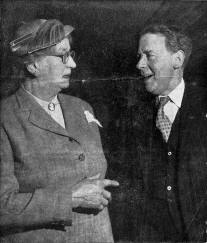
Mary Hill with Hugh Gaitskell in 1956 |
Born: 1888 died: (I.L.P. & Labour Party)
Before she married Rowland Hill, Mary Stretton worked as a tailoress. She had been active with her mother, Annie Stretton, in the Women's Labour League before WW1. Although the W.S.P.U. ceased campaigning during the war, the fight was continued by Sylvia Pankhurst. Her East London Federation of Suffrage Societies had become the Workers' Suffrage Federation. Initially it campaigned for universal suffrage and agitated among parliamentarians, with the assistance of Keir Hardie.
With the outbreak of World War I, the WSF began also to attack participation in the war. Sylvia Pankhurst's orientation toward working-class women and her willingness to work with the radical wing of the socialist movement made it attractive to many women socialists of an earlier generation who had serious reservations about the WSPU. In Leicester is had support from Miss Gittings.
In 1916, Mrs Mary Hill became secretary of the short-lived Leicester branch of the Workers' Suffrage Federation. It held a series of open air meetings and in November 1916, a conference of Suffrage and Labour organisations was convened by the Leicester Branch of the Workers' Suffrage Federation at the Foresters' Institute and was attended by delegates representing thirty-four organisations. Sylvia Pankhurst was the main speaker. The I.l.P. and W.S.F. held joint meetings in 1917 at which Sylvia Pankhurst spoke.
By the end of the war, Sylvia Pankhurst had become a somewhat sectarian revolutionary socialist and the W.S.F. had become the Workers' Socialist Federation which now rejected parliamentary elections. This was a rather contradictory position for someone who had gone to prison to get women the vote.
Mary Hill remained active in the Women's Section of the Labour Party and in 1951 as Mrs T. Rowland Hill, she became the Lady Mayoress of Leicester.
Sources: Womens' Dreadnought, 2nd & 23rd Dec 1916
|
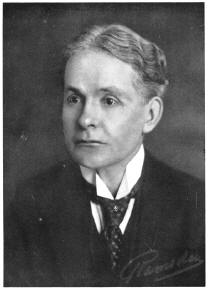 |
Born: 19th July 1870, died: 1937 (Liberal)
Teddy Hincks left school at an early age and was apprenticed at a shoe machinery firm. He became branch secretary of the A.S.E. at Gimson’s Vulcan Road works at the age of 27 on 10th July 1897. Three days later, he and his colleagues were locked out. The national employers' federation decided to lock all union members out of work as a result of strikes in London in support of a 48 hour week.
In a letter to its workers, the firm acknowledged that whilst none of its workers had gone on strike, union members were nevertheless contributing to union funds and therefore supporting the strike. The letter claimed that a 48 hours week would add to Gimson's costs and put the firm at a competitive disadvantage. The firm refused to allow any union member into work. It was reported that although only about 25% of Gimson's workforce were in the Union, the rest went on strike in sympathy with those locked out. This heavy handed response by the employers resulted in 600 firms locking out 45,000 union members. The Amalgamated Society of Engineers (A.S.E.) had healthy funds to support those locked out, but the employers' action dragged on until January 1898 when the union admitted defeat.
Hincks had gained prominence as strike leader and became a delegate to the Trades Council. He was then elected to the Town Council for Castle ward, as a Liberal, in 1900. He became chairman of three standing committees at different times. (Watch, Health and Libraries Committees)
During World War One he was a thorough going jingo and supported the refusal to allow the use of the Corn Exchange for a meeting organised by the anti-war Union of Democratic Control at which Ramsey MacDonald M.P. was to be a speaker. He believed that there were some men who should not be allowed to speak in Leicester and who were traitors and should be put in irons.
Hincks became secretary of the Charity Organisation Society in March 1903 and held the position until his death. In his role as secretary, he was not known for his progressive views on social issues. The COS supported the concept of self-help and limited government intervention to deal with the effects of poverty - it had the view that private charity was superior to public welfare.
Hincks was bitterly opposed to granting outdoor relief - that is not requiring people to suffer the indignity of the workhouse. Leicester's guardians tended to grant slightly more relief outdoors than elsewhere and Hincks was of the opinion that this led to people being better off while in receipt of poor law relief than they were in work. Hincks believed this to be 'indiscriminate, prodigal and wasteful.'
In 1921 he supported the refusal of public assistance to men “living in adultery." However, in the 1930s, he was at one with Labour on the need for slum clearance. He became Lord Mayor in 1929.
Sources: Leicester Chronicle 17th July 1897, Leicester Daily Post 1st December 1915, 25th September 1917. Leicester City Council, Roll of Lord Mayors 1928-2000, Howes, C. (ed), Leicester: Its Civic, Industrial, Institutional and Social Life, Leicester 1927
|
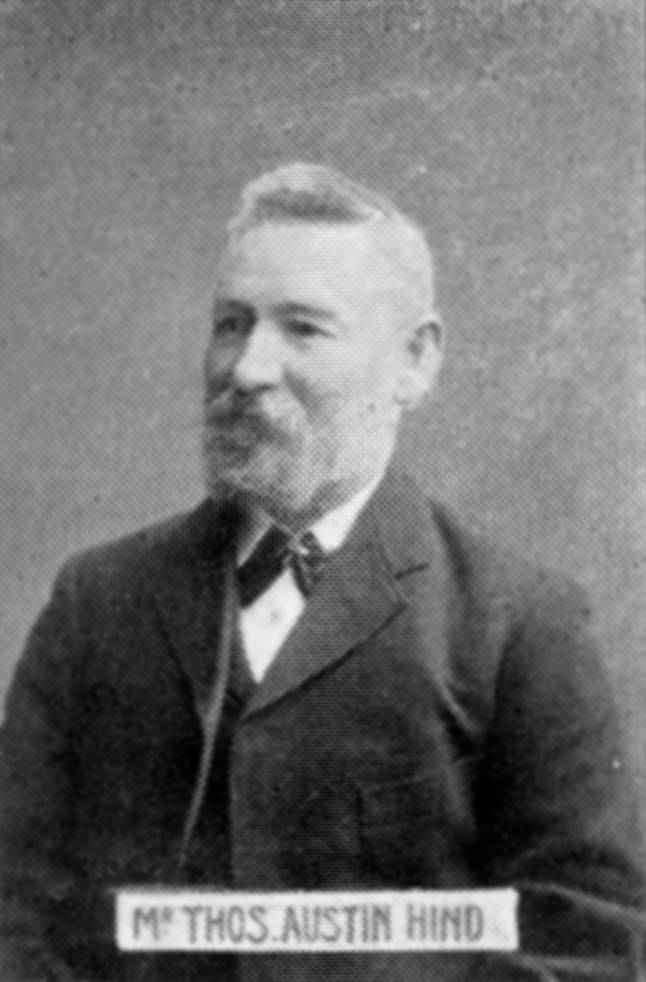
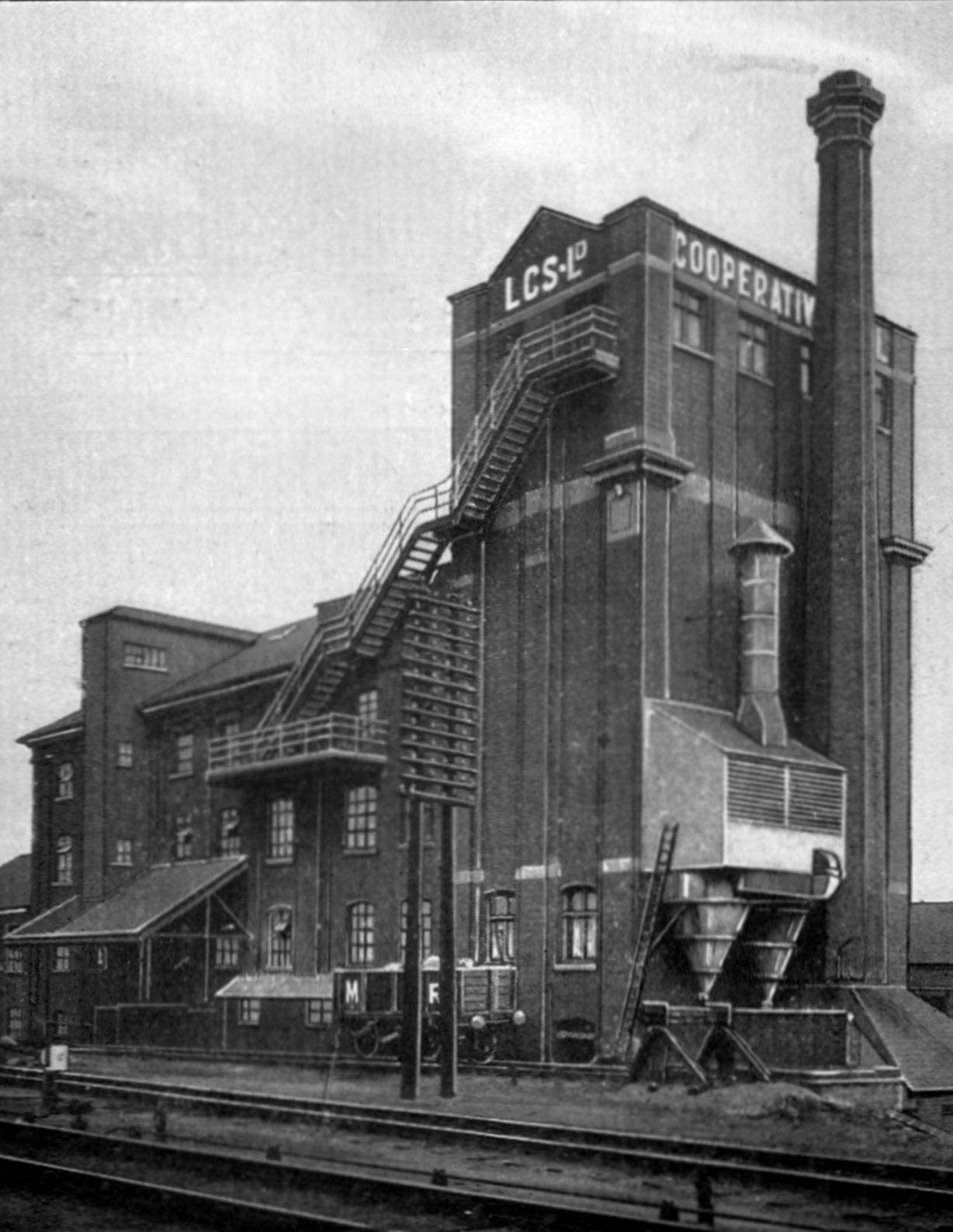
Co-op Corn mill 1911
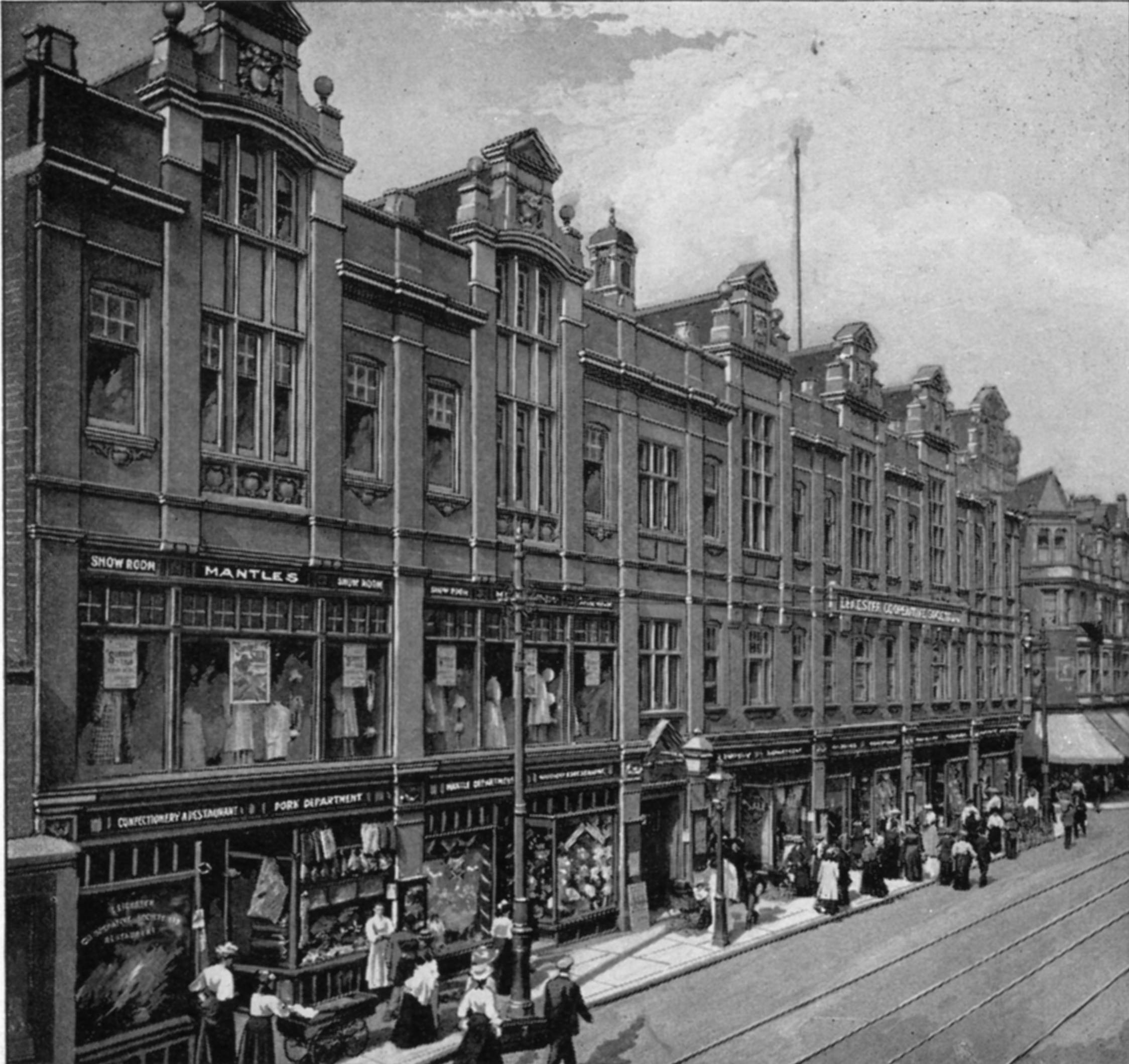
Co-op Central Stores, High Street c1910
|
Born 1838, died: 1912 (Liberal, Co-operator & architect)
Hind was an architect by profession and was a pupil of the celebrated artist John Flower. For many years he was a member of the board of the Leicester Co-operative Society and was elected to the Co-operative Wholesale Society committee in 1877. He then retired from architecture so he could carry out his duties for the C.W.S. which required him to travel extensively. He was also a Poor Law Guardian and member of the Town Council, as well as a governor of the Royal Infirmary. He was an Anglican.
In 1877, his design for the Midland Co-operative Corn Mill was completed. The five storey high structure was close to the railway, on Oak Street off Humberstone Road and was intended to supply several surrounding co-operative societies. The establishment of the flour mill was the culmination of the campaign for unadulterated flour dating back to Thomas Cook and others in the 1840s.
Hind was also the architect responsible for design of the Co-op Central Stores on High Street which opened on 10th November 1884. (now part of the Highcross shopping complex) It was a four storey building with a frontage 157 feet designed in the Queen Anne style. The outside was built with red brick, relieved with terra-cotta and and brick carved panels with pilasters and cornices in Ancaster stone. The name Leicester Co-operative Society was also formed in stone, with letters in relief. Each staircase was of stone, and consequently fireproof. The building was about 5,700 square feet in area and cost around £8,000.
A warehouse, bakery and stables on Union Street, adjacent to the Central Stores, was completed to his design in 1887. That year Hind designed the Victoria Model Lodging House on Britannia Street for Harry Wilkinson, an illiterate lodging house owner. Hind had already designed two houses in Britannia Street, one of which was for Wilkinson. At the time the Council was discussing plans to build its own lodging house in order to drive up standards. The Victoria Model lodging house can be seen as an attempt to show that the private sector could provide decent accommodation in the common lodging houses used by migrant and transient workers. The term 'model' became somewhat debased when other lodging houses owners used it to describe their establishments.
When completed, the Victoria was the largest lodging house in the street, accommodating 126 residents. The original plans show that it was built in brick around a central stair well and the plans show large communal bedrooms on each floor, each taking about 15 beds. On the ground floor there was a kitchen, office and reading room. The floors above each had one bathroom, two WCs and one urinal. Initially the toilets may well have been pail closets rather than flush WCs. Whilst the kitchen had glazed white bricks, all the other rooms were lime-washed.
The front of the building has two large moulded brick panels on the outside walls above the ground floor. The panels consist of four national stereotypes in half relief: a Welshman with a large leek, an Englishman as represented by John Bull with a rose, a Scotsman in a kilt, with a thistle and an Irishman with a shillelagh. They were intended to show that all were welcome. (apart from women). In 1892, an outbreak of small-pox occurred in the lodging houses of Britannia street, which were all promptly fumigated. Tom Barclay wrote an account of Britannia Street which appeared in the Wyvern and which includes a description of the lodging house. (This can be found in The Slums of Leicester, Ned Newitt, 2009)
Thomas Hind died shortly after returning from a trip on Co-operative business to Newcastle and he is buried in Welford Road cemetery.
Sources: Leicester Daily Post, 11th July 1877, Leicester Chronicle, 8th November 1884, 17 September 1892, 2 November 1912, The Wyvern 5th July 1895, Leicester Co-operative Society, (1898) Co-operation in Leicester, Leicester: A Souvenir of the 47th Co-operative Congress, Manchester 1915, Deposited plans, 22 April 1887, April 1889 (1887/17684, 1889/19781, ROLLR
|
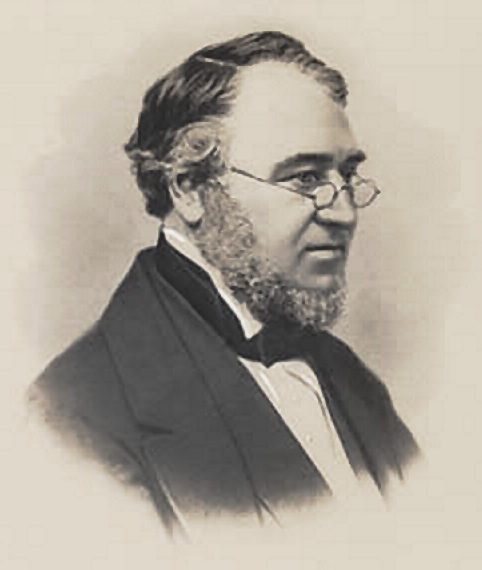
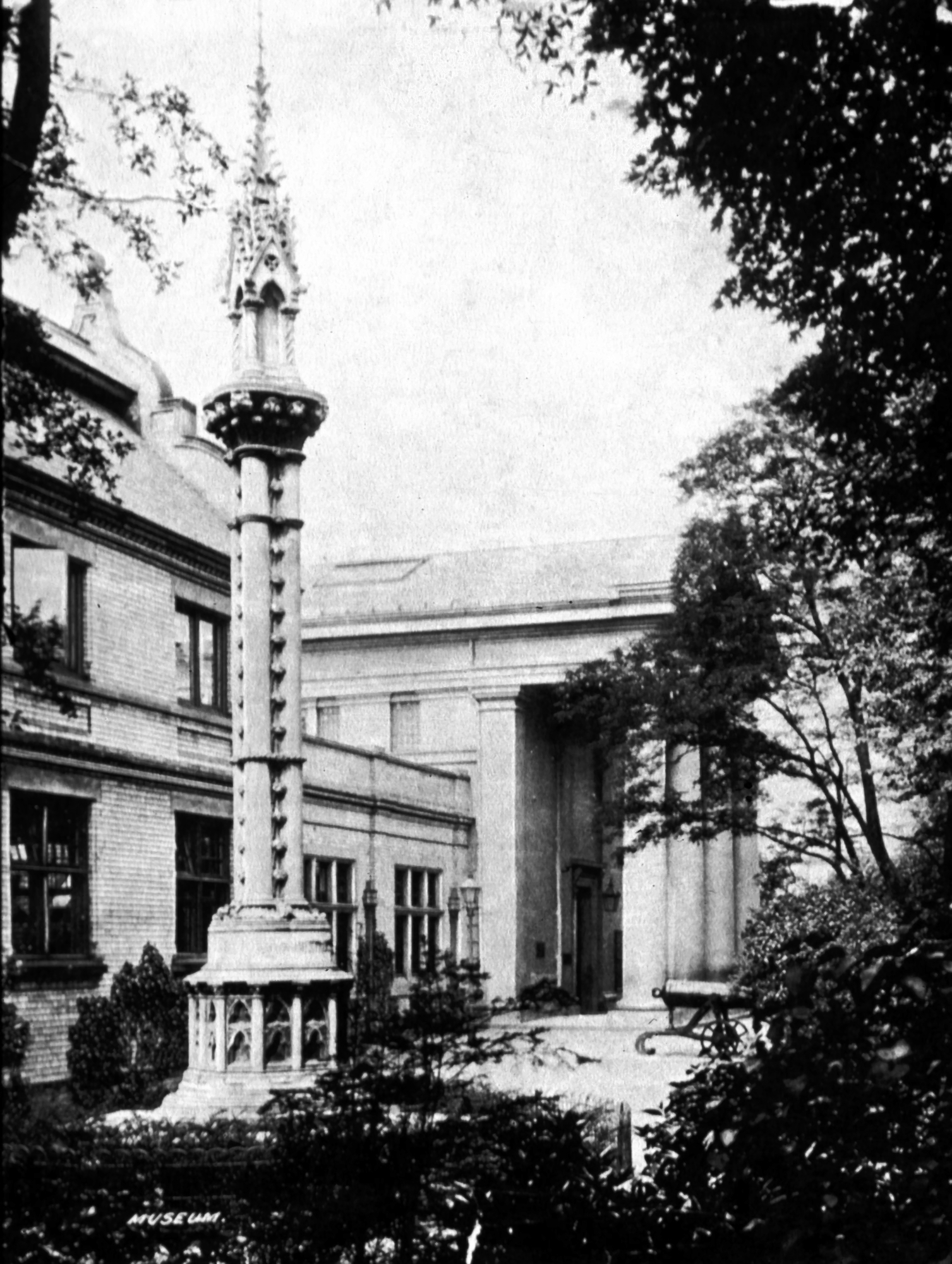
Hollings' memorial sometime after 1892
|
Born: Chelsea 15th March 1806, died: 15th September 1862 (Radical)
James Hollings came to Leicester in 1837 as second master at the new purpose built Proprietary School on New Walk. (now the Museum) The school was founded by non-conformists to rival the Collegiate School run by the Church of England. Whilst the establishment of two schools reflected of the deep sectarian divide in Leicester, the Proprietary School declared itself to be unsectarian, liberal and utilitarian. Initially did not have religion on in the curriculum and corporal punishment was rarely, if ever, resorted to. Weekly lectures at the school were often given by Hollings and were thrown open to the public as a means of supporting the school's finances.
In 1846, the poor remuneration of the head, Cyrus R. Edmonds, led to his departure and to the founding of a rival academy. Although Hollings became the headmaster at £250 per annum, his tenure was short-lived. The school lost more pupils and was no longer financially viable - it closed at Christmas 1847. A flavour of Hollings' views on education was given in his comments made following his examination of the monitorial system at the British School in Melton where he was pleased to note that pupils: "had obviously been taught to think—an essential matter in the educational process."
Before his arrival in Leicester, Hollings interests were largely literary and scholastic and during the 1830s he had a number of poems published. His The Life of Gustavus Adolphus: Surnamed the Great, King of Sweden was published in 1838. It was claimed that at this time he was a moderate Conservative. In Leicester, Hollings threw himself into the activities of the Literary and Philosophical Society. He was its president three times: (1846-47, 1853-54 and 1858-59)
During the 1840s, whilst starving Chartists were protesting over frame charges and demanding the vote, Hollings was lecturing on such diverse subjects as History of Leicester during the Civil War, (1840), Chemical Constituents of Air and Water (1842) The Life and Character of Simon de Montfort (1843). He frequently lectured at the Mechanics' Institute. Through these lectures where he was sometimes critical of earlier historians for their lack of rigour, Hollings made a significant contribution to the study of local archaeology and Roman Leicester.
One of the main objectives of the Literary & Philosophical Society was to open a museum in Leicester. In April 1841, the Society opened a museum at the New Hall which was also the site of the Mechanics' Institute. The closure of the Proprietary School was very fortuitous and Hollings was well placed to help move the museum into a permanent and more spacious location in the empty school in 1849. More than anyone else, Hollings was the founder of the museum and its main support, he added to its collection and influenced others to make contributions.
In 1849, he married Sarah Biggs (1815-1862) at the Unitarian Great Meeting. Sarah was well-educated in Greek and had previously submitted to Hollings' experiments in mesmerism. She was the sister to the highly influential Leicester manufacturers and politicians, John and William Biggs. She had been active member of the Ladies Committee of Anti-Corn Law League from the early 1840s. Having married into a family of radical politicians, James' interest in the political questions seems to have stirred. He now became a key political ally and friend of John Biggs, who clearly respected Hollings' scholarship. Following his marriage, James moved into John Biggs' nine-bedroomed mansion in Stoneygate, which stood in five acres of land where Knighton Park Road is now situated. He lived there with Sarah, her mother, John and three domestic staff until his death.
It was reported that James came into to a considerable fortune, which enabled him to retire from teaching and 'devote himself to his literary pursuits which had long been his chief delight.' This might have been what enabled him to qualify as barrister-at-law, which he did in November 1851, though he was never to practise.
In 1854, George H Smallfield sold his interest in the Leicester Mercury to the Biggs family and Hollings was entrusted with the job of running the paper. Under the editorship of Hollings, the Mercury was regarded by the Whigs as John Biggs' mouthpiece. There are many references to Hollings as being the Mercury's proprietor, but this may well have been to disguise John Biggs' interest. According to his obituary, as editor despite ample provocation:
"he never wrote a line intended to wound the feelings of those from whose opinions he conscientiously differed, nor ever exceeded the legitimate bounds of argument ."
Hollings still continued with his research and lectures; the most remarkable being his 1857 lecture on "The Social Position of Women in the nineteenth century." He had already delivered lectures on Joan of Arc and Catherine II and one might to detect influence of Sarah in this matter.
His lecture on the position of women began in classical antiquity and worked towards the C19th. He drew attention to the fact that women were part of the ministry of the early Christian church. He argued that whilst women were excluded from political power, Elizabeth I, Katherine II and Christina of Sweden had showed that women could be successful leaders. He then went on to list women who had major accomplishments in the filed of literature, science and the arts and noted that:
"let be remembered, have been attained under the disadvantages of imperfect education, and defiance of conventional prejudices eminently hostile to the mental elevation of the female sex."
He dwelt on the injustices of the married women's property laws and observed that:
"Common Law views relation of husband and wife that of master and bondswoman.... that, by the common law, the husband, in order to prevent the wife from eloping, has right to confine her his own dwelling, and restrain her from liberty for an indefinite period......."
"....when an unmarried woman has received the deadliest injury which can be inflicted upon her by the wanton betrayal of her affections, no proceedings can be instituted for the punishment of her seducer her own name, since, the eye of the law, she regarded only a chattel from the use of which its owner has been temporarily debarred. "
He wanted to see: "Equality for women in all moral responsibilities, in all intellectual advantages, all legal rights, and all social relations... so far as women themselves may desire or demand it."
Hollings became a patron of the former Chartist and poet William Whitmore and supported the fund for memorial to William Jones another Chartist poet. Hollings was not a supporter of the Temperance Movement and was Vice President of the Leicester Licensed Victuallers Association. Like John Biggs, he was noticeably quiet on the issue of the Sunday question, but he was nevertheless a supporter of its main proponent Sir Joshua Walmsley.
1857 was a difficult year for the radical cause, it was the year Sir Joshua lost his seat as a result of a coalition of Whigs and Baptists. Following his defeat, there was a very large demonstration, made up of non voters, at which Hollings presented Sir Joshua with a testimonial. In November, Hollings was elected without contest to the Town Council for Middle St Margarets ward. He had become a magistrate earlier in the year.
You would have thought that fellow historian and editor of the Leicester Chronicle James Thompson would have a deep regard and kinship with Hollings. This was not the case since by the mid 1850s, Thompson had become a die hard Whig and a bitter opponent of 'ultra radicals' and 'Chartists' which is how he described Hollings. He, no doubt, penned the Chronicle editorial which opposed Hollings' nomination as mayor describing it as a "reward for political inconsistency, unmitigated bigotry, and rancorous exclusiveness." The Chronicle also alleged that Hollings was not a 'substantial householder' since he was a lodger with John Biggs and therefore not qualified to be a councillor or mayor.
In November 1860 and the end of his year in office, Hollings stepped down as Mayor and resigned from the Town Council. It was probably then that he ceased to be editor of the Leicester Mercury. The explanation for this may be his book The Life of Marcus Tullius Cicero, which was published in 1861.
Hollings continued to sit as a magistrate and was president of the Mechanics' Institute. He was one of those 'advanced Liberals', like Thomas Emery, who supported P.A. Taylor's first bid for parliament in 1861.
On 22nd May 1862, Hollings' wife Sarah died suddenly from typhus. Hers was the fourth death within the Biggs family circle within fifteen months. It came when John Biggs financial situation had deteriorated forcing him to put his house up for sale. Following Sarah's death, Hollings was distraught and was said be "prostrate in mind and body," and that he "sank under the burden of grief." He was deeply depressed and he told friends that he would not survive it. During the night of 14th September, Hollings hung himself with a silk handkerchief from a bed-post in John Biggs' house. His body was discovered by Bigg's servant Hannah Hubbard who was bringing him his post.
Hollings was a popular and forcible political writer and a fluent and able orator, providing intellectual weight to the Radical cause in Leicester. His loss was deeply felt and William Whitmore wrote a widely praised poem in Hollings' memory which was published in 1863 by F. Hewitt.
In 1864, a memorial for James Hollings was designed in the gothic style by the Birmingham architect J. H. Chamberlain. It was paid for by subscription and was erected by Samuel Barfield of Welford Road. (He would later build Leicester's Clock Tower). The monument was situated in the grounds of the Museum and bore the inscription that it was erected by those who: "who knew the nobleness of his character, the vigour of his intellect and the tenderness of his heart." The total height the monument was about thirty two feet and it was constructed in Bolsover Snowstone which was considered to be of great beauty and considerable durability. It became known as Leicester's little Clock Tower. In 1954, the monument was found to have a crack across it and the total repair cost was estimated at £60. In 1955, the Museums Committee decided it was beyond repair and had it demolished. There seems to have been no reported protest against this act of municipal vandalism. The photograph, above left, shows the memorial sometime after 1892.
Source: Leicester Chronicle 27th November 1841, 15th June 1844, 21st March 1846, 5th & 12th November 1859, 26th January 1861, Leicester Evening Mail, 13th January 1954, 22nd January & 16th April 1955, Leicester Guardian 9th May & 27th June 1857, 5th February 1868, Leicester Journal 8th May 1840, 2nd April 1841, 10th February 1843, Leicester Mercury 3rd May 1845, 22nd December 1849, 24th May, 20 September 1862, Northampton Mercury 12th February 1842, Caroline Wessel, The Club in Exchanging Ideas Dispassionately and without Animosity, 2010, A.Temple Patterson, Radical Leicester 1780-1850, 1954, R.H. Evans, The Biggs Family of Leicester, LAHS 1972-73
|
|
Born c1910 (I.L.P., Co-operative Party & Labour Party)
Len Hollis worked at the C.W.S. box making and print works on Cranbourne Street. He was active in the Co-operative movement and the I.L.P. from an early age until the 1970s. He joined the Co-operative Comrades Circle which used to meet in the Union Street Education Offices, when he was a teenager. He was Secretary of the I.L.P. Guild of Youth until he was 25 organising rambles and social events.
He was an active anti fascist during the 1930s and along with fellow co-operative activists, R.V. Walton & P.T.A. Campell, he had his name taken by police for speaking at an anti-fascist meeting held at the Haymarket in 1936.
In 1936, he was elected to the political council of the Leicester Co-operative Society and in the late 1930s, he was vice-president of the Leicester Co-operative Party. He also served on numerous co-operative bodies including the national committee of the Co-operative Party. He became a member of the LCS board during the 1950s and was elected as president of the Leicester Co-operative Society in 1963. He served until 1978. Len Hollis Court on St Peters Estate was named in his memory
Source: Leicester Evening Mail 12th May 1936, 22nd June 1937, Leicester Chronicle 5th May 1978. OHA interview with Len Hollis by NDN
|
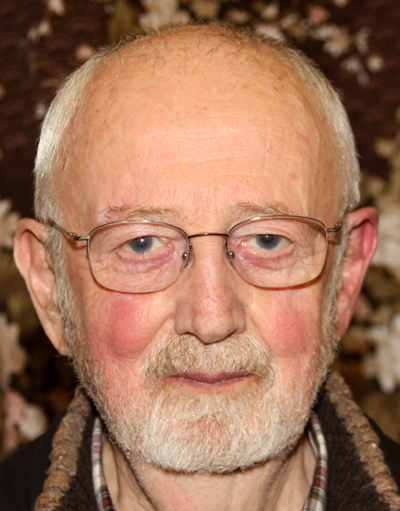 |
Born Tonypandy, died Leicester 2020 aged 89 (Friends of the Earth)
Doug Holly was one of several educationalists in Leicester who helped provide an intellectual unpinning for comprehensive and progressive education during the 1970s.
Doug went to Queen Mary College, London and trained to be a teacher at the Institute of Education, University of London. He was active in the student unions, including becoming president. He began work in some of London's first comprehensive schools and arrived in Leicester to teach at the School of Education in the 1970s.
Doug trained teachers to teach Humanities and became president of the Humanities Association. He published several books that outlined his views on education. These were: Society, Schools and Humanity (1971 and 1972), Beyond Curriculum (1973, 1974) and Education or Domination? (1974) Humanism in Adversity: Teachers' Experience of Integrated Humanities in the 1980s (1986), The Politics of Competence: a Green Left Approach to Education, (2000). Integrated Humanities, in which geography, history and English were taught together, later came under attack in Leicestershire schools, though it lives on elsewhere.
Doug retired from teaching, disillusioned by Britain's failure to develop genuine comprehensive schooling. He then became active in a wide range of campaigning organisations. He was co-ordinator of Leicester Friends of the Earth and was involved with the Red-Green Alliance, and Campaign Against Arms Trade. He also chaired the Evington Road Neighbourhood Association.
With his increasing age, he moved into care home and it was there that he died from Covid-19.
Sources: Barry Dufour and author's personal knowledge
|
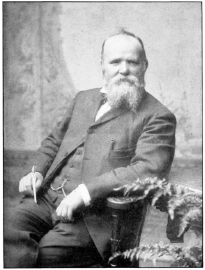 |
Born: Leicester, 1850, died: 1911 (Liberal Party, I.L.P.)
James Holmes entered the trade as a winding boy, progressing from hand frames to being a Cotton’s Patent Knitter. By the mid 1880s, he had operated every kind of knitting machine then in existence In the mid 1870s, he was elected to the executive of the Framework Knitters’ Union and soon afterwards became the unofficial leader of the power machine men. He became an official of the union in 1881. In 1885, the machine knitters seceded from the old union and he became the architect and first secretary of the Leicester and Leicestershire Amalgamated Hosiery Union. He was the first full-time paid official in the hosiery trade since the days of Nottingham’s Gravener Henson 50 years earlier. In 1886, the was a major strike which led to a series of disturbances where blacklegs were struck by missiles, windows in factories broken and 15 people arrested for rioting. It ended with concessions being made on both sides.
Holmes was an exceptional organiser and a powerful orator. In the early 1870s, he spoke on Republican platforms and was a supporter of Charles Bradlaugh. He chaired Bradlaugh's Leicester meeting in 1877 on the 'Relation of Population to Poverty' which was about birth control. This was soon after Bradlaugh's celebrated trial. During the 1870s, he was a prolific lecturer for the Secular Society, however in 1881 he declared himself to be a spiritualist, giving a series of lectures on the subject.
He was a member of the Town Council for four years, having to retire due to pressure of work. He was also a newsagent. In the 1880s, Holmes was a friend of Tom Barclay and sympathised with the early Socialists. He was a founder member of the I.L.P. in the 1890s and was a supporter of the co-operative movement. He was a member of the TUC parliamentary committee in the late 1880s and a shareholder in the Leicester Pioneer Press in the 1900s.
His life ended in disgrace when it was discovered, as he lay dying of cancer, that he had embezzled union funds on a grand scale, investing in about 200 houses in and around Leicester. They were all heavily mortgaged and the union realised little on their sale. One admirer of Holmes described this as “a sad ending to a brilliant and honourable career in the championship of Labour.” His union position was filled by Jabez Chaplin.
Sources: Midlands Free Press 5th February 1881, 13th & 20th February 1886, The Wyvern 22nd October 1897, Bill Lancaster, Radicalism Co-operation and Socialism
|
|
Died: March 1961
Violet Holmes served as City Councillor from 1945 to 1949. She was councillor for St Margaret’s and chairman of the Public Baths and Cleansing committee. She was a member of the Union of Shop and Distributive and Allied Workers and a business woman in the textile trade. In 1958, she moved the proposal to build St Margaret’s baths, the first new swimming pool built in the City since 1914.
In 1960 she told the press “I shall be very pleased to see the day when every house in the city has its own bath.” Alas, this was not to be, as she died the following year.
|
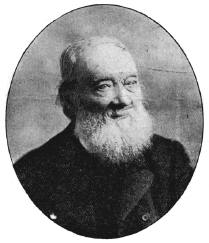 |
Born: Sileby 27th Jan 1818, died: September 1907 (Secularist and bookseller)
Following the Luddite disturbances, William Holyoak’s family migrated to the little town of Chard, in Somersetshire. He tried a variety of occupations before settling down as a tailor's apprentice. His only schooling was received at Chard, but he supplemented these scanty lessons by a good deal of reading.
On the return of the family to Leicester, they frequented the Bond Street Chapel. But when William had the tenacity to ask questions on theological subjects, and when the minister and deacon gave him unsatisfactory replies, he turned to Secularism. The 1841 census finds him working as a tailor and living in Halford Street with Josiah Gimson, John Taylor (also a tailor) and Henry Layton Knight, an Owenite Social Missionary and Knight’s 15 year old wife, Margaret, and baby. This maybe this is the ‘sort of vegetarian colony’ that he referred to in a interview in 1902.
George Jacob Holyoake (no relation), now a prominent advocate of Freethought, visited Leicester in 1843, just after his imprisonment in Gloucester Goal for blasphemy and roused the liveliest interest among Holyoak and his friends. They also owed a great deal to the influence of the venerable George Bown, a reformer whose memories went back to the days of the French Revolution and Thomas Paine. At this time Holyoak would have been a member of the Owenite Rational Party.
In 1844, Holyoak became secretary of a branch of the Anti-Persecution Union which met in the Owenite Social Institution in Leicester and was set up to defend those being prosecuted for blasphemy. It was an offshoot of the Rational Party branch and Jonathan Bairstow of the Chartists wanted to make common cause with the Union since so many Chartist were also in prison. Nothing formal seems to have resulted, though Holyoak had chaired a meeting to protest at Thomas Cooper's imprisonment.
From 1846 onwards, Holyoak continued tailoring and bookselling, and many radicals must have learned the rudiments of Rationalism through publications bought at his shop in Bond Street, or at 18, Belgrave Gate, or, still later, in Humberstone Gate.
In 1853, 1861 and 1867 it was he who called and organised the meetings to re-start the Secular Society. He stuck to the Secular Society through all its ups and downs, taking part in its business and discussions, and occasionally reading papers at its meetings. He assisted in the movement which promoted Sunday music in the parks, and in the agitation for the Sunday opening of museums and picture, galleries.
In the 1870s, he produced a hand written Club Journal for members of the Leicester Secular Club and a surviving copy from 1874-1875 can be seen here. In 1885, he pubished ‘Cyclostyle edition’ of the Rubáiyát of Omar Khayyám. The duplicator was only invented in 1880 and Macmillan who had acquired the copyright regarded Holyoak’s printings as a serious threat to their business and threatened him with a court action. The affair drew the attention of G.J. Holyoake who came to his namesake’s defence.
Excluding one year, he presided at the Bookstore adjacent to the Secular Hall 1881 to 1902. He wrote poetry often with a Secular message and, with the aid of the duplicator, he was able to distribute it via his bookshop and Secular Society. He retired in 1902 and continued to live with his son in Humberstone Gate.
Sources: Leicester Reasoner, Leicester Chronicle, 14 September 1907. Leicester Pioneer, David Nash, Secularism, Art and Freedom
|
|
(Communist Party)
Maurice Hookham graduated from the London School of Economics and Political Science in 1935 and that year visited the Soviet Union. During the war he served with the British Military Mission in Russia. He researched methods used by local Soviets in the USSR to plan the municipal economy. For five years he worked in local government, publishing A Plea for Local Government in 1949.
He became a lecturer in Government at the University College, Leicester. In 1956, he delivered two lectures on British economic problems during a visit to Moscow at the invitation of the Soviet Society for Cultural Relations with foreign countries. In 1965, as national president of the Association University Teachers, he joined students in opposing a Government suggestion that students should be given loans instead of grants. He told the Leicester Mercury that:
Psychological worries and strains among students are disturbing enough as it is. If students anxieties are increased by money troubles and need to pay back a loan, the problem could stampede into a real crisis. I think what is behind the Minister's suggestion is that student grants are costing so much. That, and the thought that we are handing to young people on a plate three years easy life at university without any incentive to work hard.
He wrote extensively and his publications include: Philosophy of Equality and Inequality (1976), Reflections On The Russian Revolution, (1967) He also contributed articles on Higher Education to Marxism Today. He is remembered by the Department of Politics and International Relations Maurice Hookham Prize for the best final year student.
Sources: Coventry Evening Telegraph 17th October 1956, The Leicester Mercury, 18 November 1965
|
|
Born Hampstead, 22 May 1915, died 1971, Leicester (Communist Party)
She was born Hilda Henriette Kuttner to a mother with the last name of Allen. Known widely as `Kutty’ in her youth, as she had acquired the nick-name at school as a contraction of her maiden name. At an early age Hilda was Interested in distant lands and in writing. When she was nine she began a pen-friendship with somebody in Japan. Two years later she formed an international pen friend club. At 15 she corresponded with George Bernard Shaw who lent her a book. A year later Virginia Woolf commented on her review of The Waves-
"l am really surprised that she enjoyed the Waves and understood so well what I was trying to do. "It is a great encouragement because most people who write reviews are not nearly so intelligent. . . is she going to be writer?"
A couple of years later Walter de la Mare looked over some of her verse and said it had "thought, imagination, feeling and gift for words." Hilda married Maurice Hookham early in 1935 in Wandsworth and the Hookhams visited the USSR in 1936. A year later, she became organiser for the National Union of Students and had joined the Communist Party.
When he was ambassador in Moscow, Sir Stafford Cripps had become friendly with Maurice Hookham. Cripps selected Kutty for the job of General Secretary of the Anglo-Soviet Youth Friendship Alliance that had been created in the summer of 1941 to demonstrate solidarity with the Soviet war effort. Whilst she kept her Party membership discreet in the hope of future career development, it was actually not a secret. The US State Department quickly ascertained that she was a member and would later make much of the supposed secrecy.
In 1944, she was appointed Secretary of the World Youth Council and was the main British contact for the World Federation of Democratic Youth. In 1949, she was described as a 'red haired student' when she addressed the Communist supported World Peace Congress. She told the delegates, who came from 59 countries that in
"more than half the world today youth is being thrown the scrapheap....They are hunting for homes that are not being built, looking for jobs that are growing fewer, seeking in vain for better education and vocational training....They are facing the firing squads, laying down their lives once more for freedom and democracy......"
In the growing cold war climate, Britain and the US began to break-up bodies associated with the wartime alliance. The World Federation of Democratic Youth now became a target of McCarthyite harassment. Kutty’s name was widely banded about in early 1950s courtrooms in America as evidence of supposedly underhand practices. She was even labelled the most dangerous woman in the world! This may have led the Hookhams to move towards a quieter life. In 1953 she began teaching at the Ashby Girls' Grammar School where she became the senior history mistress.
As Hilda Hookham, she produced a series of articles and books with connections to China and the Soviet Union. This included: Tamburlaine the Conqueror, (1962) A Short History of the Philippines (1969), A Short History of China (1972) and the Builders of Trans-Siberian Railway.
Sources: Hull Daily Mail, 22nd February 1949, Leicester Evening Mail, 17th December 1962, Graham Stevenson: Communist History
|
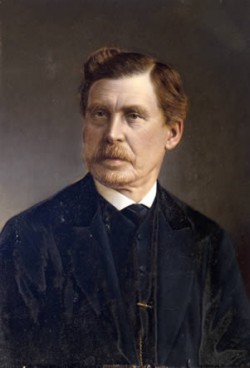 |
Born: London 1834, died: 1911 (Liberal)
John Page Hopps was a well known radical and a Unitarian minister at the Great meeting from 1876 to 1892. After studying at Leicester Baptist College, in 1856 he became minister of a Baptist meeting at Hugglescote, Leicestershire. However, the following year he moved doctrinally and geographically to liberal non-denominationalism in Birmingham. Before coming to Leicester, he had been minister at the Upperthorpe chapel in Sheffield and then the St Vincent's Street Chapel, in Glasgow. He was elected to the Glasgow School Board and was a prominent advocate of secular education.
In Leicester, he was particularly noted for the huge Sunday evening meetings he held in the Floral Hall which attracted very large numbers of working people through flowers, music, and popular preaching. He wrote hymns which are still sung by many denominations.
His radical beliefs led him to support the Democratic Association’s campaign for Liberal school board candidates and he had good relations with the Secular Society where he sometimes lectured. In 1877, he became first President of the Women’s Suffrage Society and a supporter of the Leicester Women’s Liberal Association’s attempts to get women elected to the Board of Guardians. Politically he was an advanced Liberal, a strong supporter of Irish Home Rule (a position that was unpopular with his Leicester congregation), of land reform, of anti-vivisection, and of the peace movement. In 1877, he gave his support to the opening of the free library on Sundays: "if a strong body of ratepayers desire the use of public property on the Sunday, they take dangerous ground if they resist it on religious grounds."
Hopps ran for Parliament in Paddington as a Radical Liberal against Lord Randolph Churchill in 1886. He believed that the:
“undue aggregation of capital must be met by the aggregation of labour, in other words by unionism on the one side, and co-operative industry on the other. What ultimate form this co-operative industry is to take is, of course, a problem for the statesman as well as the social reformer. …The foulness of the sweaters’ dens, and the hard unfriendly mechanical relations of the sweaters’ ‘boss’ to his hands, may be replaced by the cleanliness, the order, and the genial associations which might spring up in a co-operative clothing or cabinet-making company. Of course behind these excellent enterprises lies the double danger of successful competition by the sweaters, and of driving the trade in cheap sweater-made goods abroad, where the standard of living among the workers is even lower than among us. But such experiments are always worth trying, as doing much to bring out the gentler and more human forces of society in place of the grinding and money-making ones.”
Rejecting belief in the resurrection of the body, he was also an early advocate of cremation. He also corresponded with Oscar Wilde and was later involved with Spiritualism. In 1892 he left the Great Meeting because of the continuing tension with his congregation.
Sources: The Star, October 1888, Leicester Chronicle, 12th May 1877, Isabel Ellis, Records Of Nineteenth Century Leicester, Bill Lancaster, Radicalism Co-operation and Socialism, R. K. Webb, Oxford National Dictionary of Biography
|
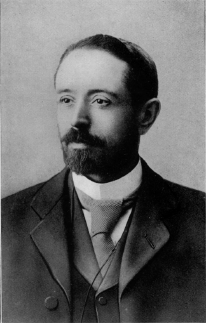 |
Born London 1856, died: Leicester, January 1909 (Liberal)
W.B. Hornidge worked in several trades before he became a laster in the shoe industry in London in 1876. He had several spells of unemployment during which he went on the tramp in search of work and moved to Northampton. In 1891, he was elected President of the Northampton branch and a member of the Board of Conciliation. He was fiercely opposed to the ‘anti-arbitrationist’ militants within the union and within two years he had became General President of the union. After six years as president, he resigned from the post in order to succeed William Inskip as general secretary in opposition to T.F. Richards.
He was a staunch Liberal-Radical and earnest and conscientious in his beliefs. In fact his forthrightness, his unwillingness to deviate from the stand he had taken and his views on arbitration made him many enemies. He was sapped and weakened by bronchial asthma which was the cause of his periodic disappearances from the Union scene. At conferences he spoke only briefly and infrequently, but despite his chronic illness he was unwilling to lay down his office. Finally he was asked, by a deeply sympathetic, but uneasy, union conference to resign. Having done so, he relapsed into an invalid condition and remained bed-ridden until his death a few months later at the age of 52. Despite being a member of Leicester Secular Society, he was given a religious funeral and was buried in Welford Road cemetery.
Sources: Leicester Pioneer, 2nd January 1909, Richards, T.F. & Poulton E.L., Fifty Years: Being The History Of The National Union Of Boot And Shoe Operatives, Alan Fox, A History of the National Union of Boot and Shoe Workers, 1958
|
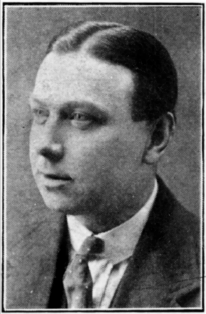 |
(I.L.P. & Labour Party)
William Howard was born in the South of Scotland of working class parents. He went to Glasgow University with the aid of a scholarship and graduated as a Master of Arts. He was a teacher for a short time before becoming Labour organiser for Gloucester. In 1919, he came to Leicester as Labour organiser, acting as the secretary of the City party. During the inter-war years, he was in charge of Labour’s election campaigns and his skills as an organiser helped the party recover from the 1918 defeat and to expand the electoral base of the party during the 1920s.
This culminated in the 1945 election victory when for the first time there were three Labour MPs and a Labour controlled City Council. He retired in 1947 and wrote a history of the party in Leicester which was published to mark its 50th anniversary. He was not on the left of the party and remained dismissive of ‘popular fronters’ and other left groups. Despite being considered something of an eligible batchelor in Labour circles, he never married, though he had a long friendship with Edith Scott. He was awarded the O.B.E. in 1949.
Sources: election address 1924, Leicester Mercury 21st October 1931, Leicester Evening Mail 11th April 1947.
|
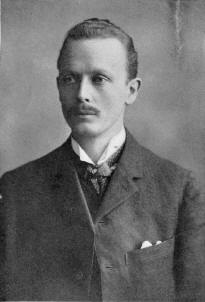 |
Born: circa 1870 Uppingham, (I.L.P. & Labour Party)
George Hubbard was orphaned at an early age and attended board schools. After leaving school he became an apprentice electrical engineer and then an apprentice auctioneer and land agent in London. He returned to Leicester, where he had relatives and secured a partnership in a hosiery firm which was not successful. He then returned to being an auctioneer and travelled the country. In 1898, he became a clerk in a trimmers and dyers factory, he later became a commercial traveller in the hosiery trade.
He said he was a politician as soon as he could read and was a radical of the ‘most advanced type.’ He heard MacDonald make his first speech at the Temperance Hall and said “If this is Socialism, I have been a Socialist for years.” He joined the I.L.P. and quickly became prominent. He was elected to the executive and became minute secretary. He was an I.L.P. delegate to the meeting called by the Trades Council which launched the Labour Representation Committee and he was made its first secretary. It was claimed that the success of the L.R.C. in Leicester was largely due to his organising ability. In 1906, he was Ramsay MacDonald’s election agent.
“Within the year practically all the trade unions of the town had formally affiliated with the Committee…From the very first the members of the Committee were unanimous and enthusiastic in maintaining a definitely independent attitude. This policy has given to the Party an influence far greater than its actual proportion of members on the local governing bodies and had led many of the workers, who were at first very critical, to throw in their lot with the Party.” (1910)
He was a member of the Shop Assistants, Warehousemen and Clerks Union and represented his society on the Trades Council. He was president of the Trades Council two years running (1907-9), president of the WEA and a member of the Town Council until 1910. Following the takeover of the ‘Leicester Pioneer’ from the old company by the L.R.C., he was one of those who guaranteed the expenses of the first three numbers out of his own pocket. He was on the committee of the new company from its formation and became secretary. He was elected as a City Councillor for Latimer Ward in 1907.
During the war, Hubbard became President of the Leicester and District Branch of the Union of Democratic Control. The U.D.C. was a pressure group formed in 1914 which called for a full examination of the war aims in public and by Parliament. Whilst the Union did not call for an immediate end to the war, it strongly opposed conscription and wartime censorship along with other restrictions on civil liberties.
Sources: Leicester Pioneer, 9th February 1907, The Labour Party Conference 1911, Official Souvenir, Leicester 1911
|
|
(Labour Party)
Bill Hynes became president of the Trades Council 1969, delegate from U.S.D.A.W. City Councillor for Wycliffe Ward elected in 1973 and 1979.
|
|
Born 9th May 1951, died: 31st March 1999 aged 47. (Labour Party, International Marxist Group, Socialist Outlook)
Son of Bill Hynes, Bernie Hynes was secretary of the Leicester Anti- Nazi League and a leading member of the Troops Out Movement. He often visited Ireland, assisting Republican prisoners and their families. He worked in the gas industry and was a member of Leicester Trades Council.
Source: author’s personal knowledge
|
|
|
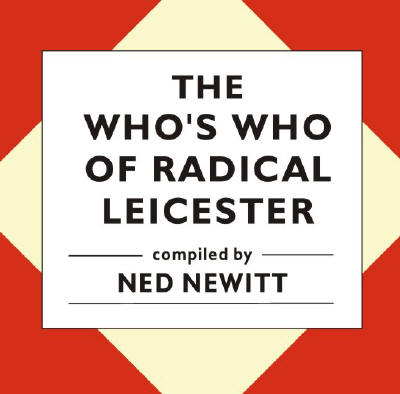 |
Back to Top |
|
© Ned Newitt Last revised: November 23, 2024.
|
|
|
Bl-Bz
Leicester's
Radical History
These are pages of articles on different topics.
Contact
|
